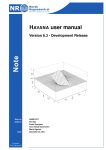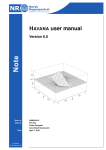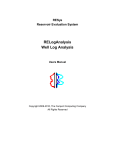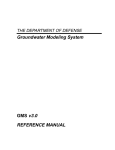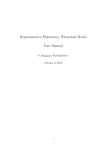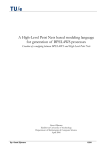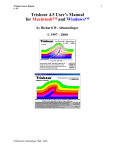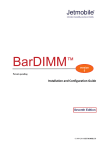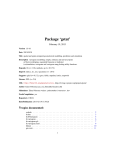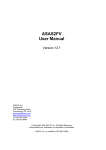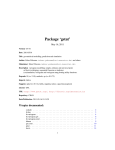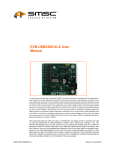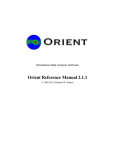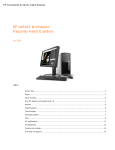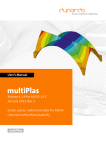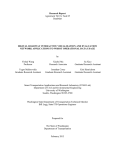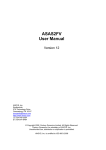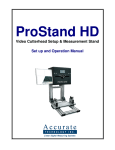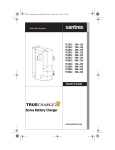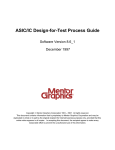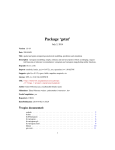Download Havana user manual - Index of
Transcript
H AVANA user manual Version 6.1 Note no Authors Date SAND/06/11 Per Røe Frode Georgsen Anne Randi Syversveen March 28, 2011 The authors Several people are, or have been, involved in the development of Havana at NR, including Kristin L. Munthe, Petter Mostad, Geir Aamodt, Jon Gjerde, Bjørn Fredrik Nielsen, Oddvar Lia, Knut Utne Hollund, Ariel Vazquez Almendral, Christian Skaug, Harald H. Soleng, Per Røe, Frode Georgsen, Bjørn Fjellvoll and Anne Randi Syversveen. Norwegian Computing Center Norsk Regnesentral (Norwegian Computing Center, NR) is a private, independent, non-profit foundation established in 1952. NR carries out contract research and development projects in the areas of information and communication technology and applied statistical modelling. The clients are a broad range of industrial, commercial and public service organizations in the national as well as the international market. Our scientific and technical capabilities are further developed in co-operation with The Research Council of Norway and key customers. The results of our projects may take the form of reports, software, prototypes, and short courses. A proof of the confidence and appreciation our clients have for us is given by the fact that most of our new contracts are signed with previous customers. Title H AVANA user manual Authors Per Røe , Frode Georgsen , Anne Randi Syversveen Date March 28, 2011 Publication number SAND/06/11 Abstract H AVANA is a program for simulating subseismic faults in petroleum reservoirs, and for integrating the effects of these faults into the reservoir description. The H AVANA project has a long history, the original sponsors being Statoil, BP, and Norsk Hydro. Other sponsors include Conoco Norge AS, Saga Petroleum AS and Centre for Integrated Petroleum Research at University of Bergen. Keywords fault, simulation, sealing, stochastic, software Target group H AVANA users Availability Open Project Project number Research field Fault modelling Number of pages 62 Copyright © 2011 Norwegian Computing Center 3 Contents 1 User Reference . . . . . . . . . . . . . . . . . . . . . 1.1 Model file syntax . . . . . . . . . . . . . . . . . . . 1.2 Commands common to the whole program . . . . . . . . . 1.2.1 Command: INPUT_AND_OUTPUT_DIRECTORY. . . . 1.2.2 Command: INPUT_DIRECTORY . . . . . . . . . . 1.2.3 Command: OUTPUT_DIRECTORY . . . . . . . . . 1.2.4 Command: READ . . . . . . . . . . . . . . . 1.2.5 Command: SEED . . . . . . . . . . . . . . . 1.2.6 Command: INPUT_SEED_FILE . . . . . . . . . . 1.2.7 Command: LEVEL_OF_INFORMATION . . . . . . . 1.2.8 Command: OUTPUT_LOG . . . . . . . . . . . . 1.3 Input of fault model/structural model from RMS . . . . . . . . 1.3.1 Command: INPUT_FAULTS. . . . . . . . . . . . 1.3.2 Command: INPUT_STRUCTURAL_MODEL. . . . . . 1.3.3 Command: FAULT_LINE_POLYGON . . . . . . . . 1.3.4 Command: SFM_PARAMETERS . . . . . . . . . . 1.3.5 Command: VARIO_TYPE . . . . . . . . . . . . 1.3.6 Command: FAULT_DISPLACEMENT_LENGTH . . . . 1.3.7 Command: FAULT_LENGTH_HEIGHT. . . . . . . . 1.4 Simulate: Simulate sub-seismic faults . . . . . . . . . . . 1.4.1 Command: INPUT_FAULTS. . . . . . . . . . . . 1.4.2 Command: FAULT_LINE_POLYGON . . . . . . . . 1.4.3 Command: SFM_PARAMETERS . . . . . . . . . . 1.4.4 Command: VARIO_TYPE . . . . . . . . . . . . 1.4.5 Command: SFM_FAULT_DISPLACEMENT_LENGTH . . 1.4.6 Command: SFM_FAULT_LENGTH_HEIGHT . . . . . 1.4.7 Command: OUTPUT_HAVANA_FAULTS . . . . . . . 1.4.8 Command: FAULTS_STATISTICS . . . . . . . . . 1.4.9 Command: SIMULATION_VOLUME. . . . . . . . . 1.4.10 Command: VERTICAL_BUFFER_SIZE . . . . . . . 1.4.11 Command: INPUT_FAULT_CENTER_LINES . . . . . 1.4.12 Command: FAULT_CENTER_LINES_OPTION . . . . . 1.4.13 Command: INPUT_WELL_PATHS . . . . . . . . . 1.4.14 Command: INPUT_WELLOBS_OF_FAULTS . . . . . 1.4.15 Command: INPUT_WELLOBS_OF_NOFAULTS . . . . 1.4.16 Command: NUMBER_OF_FAULTS . . . . . . . . . 1.4.17 Command: RELATIVE_INTENSITY . . . . . . . . . 1.4.18 Command: RELATIVE_INTENSITY_GRID . . . . . . 1.4.19 Command: DISPLACEMENT_INTENSITY . . . . . . 1.4.20 Command: DISPLACEMENT_INTENSITY_GRID . . . . 1.4.21 Command: OUTPUT_DISPLACEMENT_INTENSITY . . 1.4.22 Command: DISPLACEMENT_INTENSITY_PARAMETERS H AVANA user manual . . . . . . . . . . . . . . . . . . . . . . . . . . . . . . . . . . . . . . . . . . . . . . . . . . . . . . . . . . . . . . . . . . . . . . . . . . . . . . . . . . . . . . . . . . . . . . . . . . . . . . . . . . . . . . . . . . . . . . . . . . . . . . . . . . . . . . . . . . . . . . . . . . . . . . . . . . . . . . . . . . . . . . . . 8 8 8 8 9 9 9 9 10 10 10 10 11 11 11 12 12 13 13 13 13 13 13 13 13 13 13 14 14 15 15 16 16 16 17 17 17 18 18 19 19 19 4 1.5 1.6 1.7 1.4.23 Command: DISPLACEMENT . . . . . . . . . . . 1.4.24 Command: FAULT_DISPLACEMENT_LENGTH . . . . 1.4.25 Command: FAULT_LENGTH_HEIGHT. . . . . . . . 1.4.26 Command: FAULT_AVERAGE_REVERSEDRAG . . . . 1.4.27 Command: ORIENTATION_GROUPS . . . . . . . . 1.4.28 Command: STRIKE . . . . . . . . . . . . . . 1.4.29 Command: DIP . . . . . . . . . . . . . . . . 1.4.30 Command: FAULT_TRUNCATION . . . . . . . . . 1.4.31 Command: REPULSION . . . . . . . . . . . . . 1.4.32 Command: DISPLACEMENT_WEIGHT . . . . . . . 1.4.33 Command: NUMBER_OF_FAMILIES . . . . . . . . 1.4.34 Command: CHILDREN_PARAMETERS . . . . . . . 1.4.35 Command: CHILDREN_STRIKE . . . . . . . . . . 1.4.36 Command: CHILDREN_DIP . . . . . . . . . . . 1.4.37 Command: CHILDREN_PARAMETERS_GENERAL . . . 1.4.38 Command: CHILDREN_PARAMETERS_MOTHER_TYPE 1.4.39 Command: RELAY_RAMPS . . . . . . . . . . . 1.4.40 Command: NUMBER_OF_ITERATIONS . . . . . . . 1.4.41 Command: FAULTNAME_PREFIX . . . . . . . . . ModifyFaultSurface: Change SFM fault properties . . . . . . . 1.5.1 Command: INPUT_FAULTS. . . . . . . . . . . . 1.5.2 Command: FAULT_LINE_POLYGON . . . . . . . . 1.5.3 Command: SFM_PARAMETERS . . . . . . . . . . 1.5.4 Command: VARIO_TYPE . . . . . . . . . . . . 1.5.5 Command: FAULT_DISPLACEMENT_LENGTH . . . . 1.5.6 Command: FAULT_LENGTH_HEIGHT. . . . . . . . 1.5.7 Command: VARIOGRAM_GEOMETRY . . . . . . . 1.5.8 Command: FAULT_PICKS_FILE . . . . . . . . . . 1.5.9 Command: OUTPUT_FAULTS. . . . . . . . . . . 1.5.10 Command: OUTPUT_ORIGINAL_HAVANA_FAULTS . . 1.5.11 Command: OUTPUT_MODIFIED_HAVANA_FAULTS . . 1.5.12 Command: TRANSFORM . . . . . . . . . . . . 1.5.13 Command: LOCAL_ROTATION . . . . . . . . . . ModifyDisplacement: Change displacement for SFM fault . . . . 1.6.1 Command: INPUT_FAULTS. . . . . . . . . . . . 1.6.2 Command: FAULT_LINE_POLYGON . . . . . . . . 1.6.3 Command: SFM_PARAMETERS . . . . . . . . . . 1.6.4 Command: VARIO_TYPE . . . . . . . . . . . . 1.6.5 Command: FAULT_DISPLACEMENT_LENGTH . . . . 1.6.6 Command: FAULT_LENGTH_HEIGHT. . . . . . . . 1.6.7 Command: OUTPUT_FAULTS. . . . . . . . . . . 1.6.8 Command: OUTPUT_ORIGINAL_HAVANA_FAULTS . . 1.6.9 Command: OUTPUT_MODIFIED_HAVANA_FAULTS . . 1.6.10 Command: SCALE_DISPLACEMENT . . . . . . . . 1.6.11 Command: ADD_THROW . . . . . . . . . . . . SimulateFaultSurface: Simulate SFM faults . . . . . . . . . 1.7.1 Command: INPUT_FAULTS. . . . . . . . . . . . 1.7.2 Command: FAULT_LINE_POLYGON . . . . . . . . 1.7.3 Command: SFM_PARAMETERS . . . . . . . . . . H AVANA user manual . . . . . . . . . . . . . . . . . . . . . . . . . . . . . . . . . . . . . . . . . . . . . . . . . . . . . . . . . . . . . . . . . . . . . . . . . . . . . . . . . . . . . . . . . . . . . . . . . . . . . . . . . . . . . . . . . . . . . . . . . . . . . . . . . . . . . . . . . . . . . . . . . . . . . . . . . . . . . . . . . . . . . . . . . . . . . . . . . . . . . . . . . . . . . . . . . . . . 20 21 21 22 22 23 24 25 25 26 26 26 26 27 27 28 29 30 30 31 31 31 31 31 31 31 31 31 31 31 31 32 32 33 33 33 33 33 33 33 33 33 33 33 34 35 35 35 35 5 1.8 1.9 1.10 1.11 1.7.4 Command: VARIO_TYPE . . . . . . . . . . . . . . . . 1.7.5 Command: FAULT_DISPLACEMENT_LENGTH . . . . . . . . 1.7.6 Command: FAULT_LENGTH_HEIGHT. . . . . . . . . . . . 1.7.7 Command: OUTPUT_FAULTS. . . . . . . . . . . . . . . 1.7.8 Command: OUTPUT_ORIGINAL_HAVANA_FAULTS . . . . . . 1.7.9 Command: OUTPUT_MODIFIED_HAVANA_FAULTS . . . . . . 1.7.10 Command: SIMULATION . . . . . . . . . . . . . . . . 1.7.11 Command: FAULT_VOLUME_WIDTH . . . . . . . . . . . . 1.7.12 Command: VARIOGRAM_GEOMETRY . . . . . . . . . . . 1.7.13 Command: DISTRIBUTION . . . . . . . . . . . . . . . . 1.7.14 Command: FAULT_PICKS_FILE . . . . . . . . . . . . . . 1.7.15 Command: FAULT_PICK_UNCERTAINTY . . . . . . . . . . SimulateDisplacement: Fault displacement field modeling . . . . . . . . 1.8.1 Command: INPUT_FAULTS. . . . . . . . . . . . . . . . 1.8.2 Command: FAULT_LINE_POLYGON . . . . . . . . . . . . 1.8.3 Command: SFM_PARAMETERS . . . . . . . . . . . . . . 1.8.4 Command: VARIO_TYPE . . . . . . . . . . . . . . . . 1.8.5 Command: FAULT_DISPLACEMENT_LENGTH . . . . . . . . 1.8.6 Command: FAULT_LENGTH_HEIGHT. . . . . . . . . . . . 1.8.7 Command: OUTPUT_FAULTS. . . . . . . . . . . . . . . 1.8.8 Command: OUTPUT_ORIGINAL_HAVANA_FAULTS . . . . . . 1.8.9 Command: OUTPUT_MODIFIED_HAVANA_FAULTS . . . . . . 1.8.10 Command: SEISMIC_RESOLUTION . . . . . . . . . . . . 1.8.11 Command: SIMULATION . . . . . . . . . . . . . . . . AddFaults: Add Faults to surface . . . . . . . . . . . . . . . . . 1.9.1 Command: INPUT_FAULTS. . . . . . . . . . . . . . . . 1.9.2 Command: FAULT_LINE_POLYGON . . . . . . . . . . . . 1.9.3 Command: SFM_PARAMETERS . . . . . . . . . . . . . . 1.9.4 Command: VARIO_TYPE . . . . . . . . . . . . . . . . 1.9.5 Command: FAULT_DISPLACEMENT_LENGTH . . . . . . . . 1.9.6 Command: FAULT_LENGTH_HEIGHT. . . . . . . . . . . . 1.9.7 Command: HORIZON . . . . . . . . . . . . . . . . . . UpdatePoints: Update point sets after modifying or simulating faults . . . . 1.10.1 Command: INPUT_ORIGINAL_HAVANA_FAULTS . . . . . . . 1.10.2 Command: INPUT_MODIFIED_HAVANA_FAULTS . . . . . . . 1.10.3 Command: INPUT_STRUCTURAL_MODEL. . . . . . . . . . 1.10.4 Command: HORIZON . . . . . . . . . . . . . . . . . . 1.10.5 Command: FAULT_LINES . . . . . . . . . . . . . . . . 1.10.6 Command: NODEFILE . . . . . . . . . . . . . . . . . 1.10.7 Command: PRINT_ONLY_FAULTLINES_FROM_CHANGED_FAULTS 1.10.8 Command: FAULT_BLOCK_DEFINITION. . . . . . . . . . . 1.10.9 Command: FILTER_DISTANCE . . . . . . . . . . . . . . 1.10.10 Command: NOT_FILTER_POINTS_CROSSING_FAULTS. . . . . 1.10.11 Command: FILTERING_FROM_WELLS . . . . . . . . . . . 1.10.12 Command: OUTPUT_HORIZONS . . . . . . . . . . . . . 1.10.13 Command: OUTPUT_FAULTLINES . . . . . . . . . . . . . Restore: Restore surfaces . . . . . . . . . . . . . . . . . . . 1.11.1 Command: INPUT_FAULTS. . . . . . . . . . . . . . . . 1.11.2 Command: FAULT_LINE_POLYGON . . . . . . . . . . . . H AVANA user manual 35 35 35 35 35 35 35 35 35 36 36 37 38 38 38 38 38 38 38 38 38 38 38 38 39 39 39 39 39 39 39 39 40 40 40 40 40 40 41 41 41 41 41 42 42 42 43 43 43 6 1.12 1.11.3 Command: SFM_PARAMETERS . . . . . . 1.11.4 Command: VARIO_TYPE . . . . . . . . 1.11.5 Command: FAULT_DISPLACEMENT_LENGTH 1.11.6 Command: FAULT_LENGTH_HEIGHT. . . . 1.11.7 Command: HORIZON . . . . . . . . . . TestFaults: Test reading and writing of faults . . . . . 1.12.1 Command: INPUT_FAULTS. . . . . . . . 1.12.2 Command: OUTPUT_FAULTS. . . . . . . 1.12.3 Command: FAULT_LINE_POLYGON . . . . 1.12.4 Command: SFM_PARAMETERS . . . . . . 1.12.5 Command: VARIO_TYPE . . . . . . . . 1.12.6 Command: FAULT_DISPLACEMENT_LENGTH 1.12.7 Command: FAULT_LENGTH_HEIGHT. . . . . . . . . . . . . . . . . . . . . . . . . . . . . . . . . . . . . . . . . . . . . . . . . . . . . . . . . . . . . . . . . . . . . . . . . . . . . . . . . . . . . . . . . . . . . . . . . . . . . . . . . . . . 43 43 43 43 43 44 45 45 45 45 45 45 45 . . . . . . . . . . . . . . . . . . . . . . . . . . . . . . . . . . . . . . . . . . . . . . . . . . . . . . . . . . . . . . . . . . . . . . . . . . . . . . . . . . . . . . . . . . . . A File formats . . . . . . . . . . . . . . . . . . . . . . A.1 Input of structural model exported from RMS - new format . . . A.1.1 Structural model definition . . . . . . . . . . . A.1.2 Fault surface file . . . . . . . . . . . . . . . A.1.3 Fault line file . . . . . . . . . . . . . . . . A.1.4 Horizon file . . . . . . . . . . . . . . . . . A.2 Input of fault model from RMS on old format . . . . . . . . A.3 Input of Elliptic faults . . . . . . . . . . . . . . . . A.4 Output of fault statistics . . . . . . . . . . . . . . . A.5 Fault center lines file. . . . . . . . . . . . . . . . . A.6 Well data files . . . . . . . . . . . . . . . . . . . A.6.1 Input of well paths . . . . . . . . . . . . . . A.6.2 Input of well observations of faults . . . . . . . . A.6.3 Input of well observations of faults with depth uncertainty A.6.4 Input of well intersection thresholds . . . . . . . . A.6.5 Input of horizon wellpicks . . . . . . . . . . . A.7 Havana-specific file type: Havana faults . . . . . . . . . . A.7.1 Format for the “EllFaults” file . . . . . . . . . . A.8 Horizons . . . . . . . . . . . . . . . . . . . . . A.9 Fault Blocks . . . . . . . . . . . . . . . . . . . . A.10 Nodefile . . . . . . . . . . . . . . . . . . . . . A.11 RMS Internal Point Format . . . . . . . . . . . . . . A.12 Internal Havana Format . . . . . . . . . . . . . . . . . . . . . . . . . . . . . . . . . . . . . . 46 46 46 49 50 51 51 51 52 53 53 53 53 54 54 55 55 55 55 56 56 57 57 B License manager . . . . . . . . . . . . . . . . . . . . . . . . . 59 C Installation script and start-up script . . . . . . . . . . . . . . . . . 60 Index . . . . . . . . . . . . . . . . . . . . . . . . . . . . . . . 61 H AVANA user manual 7 1 User Reference H AVANA is run from the UNIX command line by writing “havana” directly followed by the name of the model file. If no model file name is given, the program will look for a file named “havana.model” in the current directory and use this file, if possible. The program is fully controlled by commands and arguments/parameters in one or more model files. 1.1 Model file syntax Comments can be inserted into model files using ’!’ (for single line comments) or pairs of ’< and ’>’ (for multi-line comments). All lines containing a ’!’ are regarded as blank from that point on. Everything starting with a ’<’ and ending with a ’>’ is also disregarded. All non-blank entries must be commands: They must start with a command word and end with a ’\’ character. Between the command word and the backslash is the argument list, which in general may contain any number of arguments. The command ACTION divides the model file into sections. Before the first ACTION command comes a section with some commands pertaining to the whole program, see Section 1.2. The allowed commands in each following section depends on the specific ACTION command heading it. Within each section, the commands may appear in any order, but any command (except READ commands) may appear at most once. READ commands make it possible to read commands from other files, so that one may split the model file into several smaller files (see Section 1.2.4). The different sections correspond to different modules within H AVANA. Each module is independent of the others in that it reads all of its input from files, and writes all results to files before the next module is started. This is slightly inefficient, but has the advantage that H AVANA may be restarted at any module that causes it to terminate, instead of at the very beginning. The whole model file is checked before any part of the actual program is run. If any errors are found, they are listed, and the program is terminated. Note that there may still be errors in the input files read by the program: It is not checked that for example E CLIPSE input files or RMS input files are correct before the program execution reaches the place where they are read in. 1.2 Commands common to the whole program Many H AVANA commands may only appear in specific sections, i.e., below specific ACTION commands. However, some commands may appear before any action commands, or in any section, or indeed anywhere. These are listed below. 1.2.1 Command: INPUT_AND_OUTPUT_DIRECTORY Optional: May only appear before any of the ACTION commands. Description: All files read and written by the program will be assumed located relative to this directory. H AVANA user manual 8 Arguments: One. The name of a directory, either relative to the one where the program is run, or absolute. Examples: INPUT_AND_OUTPUT_DIRECTORY ../mydir \ INPUT_AND_OUTPUT_DIRECTORY /user/geir/havana/example/ \ 1.2.2 Command: INPUT_DIRECTORY Optional: May only appear in the ACTION sections. Description: This command overrides any INPUT_AND_OUTPUT_COMMAND with relation to INPUT files, and redirects the search for input files in the current ACTION section. Arguments: One. The name of a directory, either relative to the one where the program is run, or absolute. Example: INPUT_DIRECTORY newfield/data \ 1.2.3 Command: OUTPUT_DIRECTORY Optional: May only appear in the ACTION sections. Description: This command overrides any INPUT_AND_OUTPUT_COMMAND with relation to OUTPUT files, and redirects the writing of output files in the current ACTION section. Arguments: One. The name of a directory, either relative to the one where the program is run, or absolute. Example: OUTPUT_DIRECTORY results \ 1.2.4 Command: READ Optional: May appear anywhere, any number of times. Description: This command includes any set of valid H AVANA commands written in a separate file. The effect is as if the commands had appeared directly in the main model file. Any commands may appear in such files (including new READ commands) except ACTION commands. This guarantees that one will always know what modules are run just by reading the top model file. Arguments: The name of one or more files with H AVANA commands. Examples: READ simulate.model \ READ sim1.model sim2.model \ 1.2.5 Command: SEED Optional: If neither a seed number or a seed file are available, a random seed number will be used. If both are available, the seed number given in the seed file is used. Description: Sets the seed for the random number generator. Arguments: One. An integer between 0 and 4294967295. Example: SEED 74839254 \ H AVANA user manual 9 1.2.6 Command: INPUT_SEED_FILE Optional: If neither a seed number or a seed file are available, a random seed number will be used. If both are available, the seed number given in the seed file is used. Description: Reads and sets the seed for the random number generator from a file. If the file does not exists, it will be created. The value of the seed after the simulation is written out to the file. Arguments: One. The name of an ASCII file containing one single integer between 0 and 4294967295. Example: INPUT_SEED_FILE seed.dat \ 1.2.7 Command: LEVEL_OF_INFORMATION Optional: May appear anywhere. If it appears before any ACTION command, it affects the whole program, while if it appears below an ACTION command, it affects only that section. Description: The command regulates the amount of information output to screen and to the log file. There are six levels of information: 0, 1, 2, 3, 4 and 5. If level 0 is used, only warnings and errors are written. Level 4 and 5 give debug information. When LEVEL_OF_INFORMATION does not appear, information level 0 is used. Note that even if the information level is zero, information at level 1 will be output to the log file. Arguments: One. An integer 0, 1, 2, 3, 4 or 5. If LEVEL_OF_INFORMATION appears without any argument, it corresponds to information level 1. Example: LEVEL_OF_INFORMATION 2 \ 1.2.8 Command: OUTPUT_LOG Optional: May only appear before any ACTION commands. Description: Causes information from the program to be saved in a log file. The information is the same as that appearing on the screen, but if the information level is zero, information at level 1 will still be output to the log file. Arguments: One. The name of the log-file. Example: OUTPUT_LOG logfile.dat \ 1.3 Input of fault model/structural model from RMS Several commands are needed for input of a fault model from RMS. These commands can only appear below the ACTION keyword, but they are common for all actions. There are two ways to export fault data from the integrated structural model in RMS. A manual export of the different types of data which is available in RMS 2009 and newer, and a single click export of a complete structural model which currently only is available in special development versions of RMS 2011. With old RMS, the command INPUT_FAULTS specifies where the fault data are located. Additionally the fault lines have to be given with the FAULT_LINE_POLYGON command. For details about this export format, see A.2. When using the new export format, the directory containing the structural model is given by the INPUT_STRUCTURAL_MODEL command. The command FAULT_LINE_POLYGON is not in H AVANA user manual 10 use, except for giving additional input data sets in the UpdatePoints action. For details about this export format, see A.1. The directory containing the fault model file, and the fault surfaces is given by the INPUT_FAULTS command, the fault displacement is deduced from the fault lines given by the FAULT_LINE_POLYGON command, additional parameters needed to generate the displacement field are given by the SFM_PARAMETERS, VARIO_TYPE, FAULT_DISPLACEMENT_LENGTH and FAULT_LENGTH_HEIGHT keywords. The type of fault given in SFM_PARAMETERS is ignored in the new export format since the same information about whether a fault is normal or reverse is exported directly by RMS in the fault_model file. 1.3.1 Command: INPUT_FAULTS Necessary Only used for import of faults from RMS on old format. Description: Specifies the name of the directory containing the fault files. The directory must contain a faultmodel.txt file together with the fault surfaces as point sets. To obtain the faultmodel.txt file the RMS_FAULT_MODEL_FILENAME environment variable should be set to the desired location of this file. The file is then generated whenever a Fault modelling job is run within RMS. The fault surfaces as point sets are generated by extracting the fault surfaces from the structural model within RMS and export the resulting point sets using the Roxar text format. Arguments: One. The directory. Example: INPUT_FAULTS faults/sfm_faults \ 1.3.2 Command: INPUT_STRUCTURAL_MODEL Necessary Only used for import of data on new RMS export format. Description: Specifies the name of the directory containing the fault files when using new RMS. The directory must contain a fault_model file together with the fault surfaces as point sets. To obtain the fault_model file use the command ExtractFaultLinesToFile under StructuralModels/Horizons in RMS. Arguments: One. The directory. Example: INPUT_STRUCTURAL_MODEL faults/sfm_faults \ 1.3.3 Command: FAULT_LINE_POLYGON Necessary If the faults are given on the old format. Description: List of files with fault line polygons exported from RMS. One file corresponds to one horizon, and contains fault lines for more than one fault. The fault lines are generated in RMS by extracting fault lines from the horizon model within the structural model. The resulting fault lines are placed in the Horizons list and exported using the Roxar text format. Files of type RMSInternalPoints (control points) can also be H AVANA user manual 11 read. Then information about hw/fw and fault name are also given in the file, and this information is also read and used. Arguments: One or more. Each argument specifies a file containing a set of fault line polygons. Example: FAULT_LINE_POLYGON TopC_faultlines.points ; BaseA_faultlines.points \ 1.3.4 Command: SFM_PARAMETERS Necessary Description: Parameters describing the fault and corresponding influence area. Arguments A list of faults with corresponding parameters. For each fault the fault name, fault throw distribution (=1.0 all throw is distributed on hanging wall side, =0.0 all throw is distributed on foot wall), reverse drag distance (measured laterally) and whether the fault is normal (=1) or reverse (=-1) is given. For faults exported on the new format the information whether a fault is normal or reverse is exported from RMS in the fault_model file. If the name ’default’ is given the following parameters applies to all faults with no explicitly given parameters. Example: SFM_PARAMETERS F3 1.0 500 1 ; F1 0.7 2000 -1 ; default 0.5 1000 1 \ 1.3.5 Command: VARIO_TYPE Necessary Description: Specifies a variogram model used when modeling the displacement field on the fault surface. Arguments: Four or five: 1. Variogram type. Possible variogram types are: • GAUSSIAN - Gaussian variogram. • SPHERICAL - Spherical variogram. • EXPONENTIAL - Exponential variogram. • GENERAL_EXPONENTIAL - General exponential variogram. An additional parameter giving the power must be given. 2. Range in strike direction. Higher range gives smoother fault surfaces. 3. Range in dip direction. Higher range gives smoother fault surfaces. 4. Anisotrophy angle in degrees. Use this if you want to rotate the direction of the ranges. 5. The power. Only for general exponential variograms. Examples: H AVANA user manual 12 VARIO_TYPE SPHERICAL 1000 500 0.0 \ 1.3.6 Command: FAULT_DISPLACEMENT_LENGTH Optional Description: The relationship between maximum displacement and length of fault. Arguments: Two constants, a and b, where length = (maximumDisplacement/b)(1/a) Default values, if command is not defined, are 1.0 and 0.05. Examples: FAULT_DISPLACEMENT_LENGTH 1.0 0.05 \ 1.3.7 Command: FAULT_LENGTH_HEIGHT Optional Description: The relationship between length and height of fault. Arguments: One constant, c, where height = (length/c) Default value, if command is not defined, is 2.0. Examples: FAULT_LENGTH_HEIGHT 2.0 \ 1.4 Simulate: Simulate sub-seismic faults ACTION Simulate \ This module is used when parametric faults are simulated, possibly conditioned on the presence of known faults and well observations of the geological layers. The simulation is done according to the specified intensity maps and distributions for the fault properties. 1.4.1 Command: INPUT_FAULTS See 1.3.1. 1.4.2 Command: FAULT_LINE_POLYGON See 1.3.3. 1.4.3 Command: SFM_PARAMETERS See 1.3.4. 1.4.4 Command: VARIO_TYPE See 1.3.5. 1.4.5 Command: SFM_FAULT_DISPLACEMENT_LENGTH See 1.3.6. 1.4.6 Command: SFM_FAULT_LENGTH_HEIGHT See 1.3.7. 1.4.7 Command: OUTPUT_HAVANA_FAULTS Necessary Description: Specifies a directory for output of the deterministic and simulated faults. The faults are all written on the H AVANA format used by H AVANA 5. The output directory will only contain the simulated elliptic faults. H AVANA user manual 13 Arguments: One. The name of the directory where the faults are to be written. Example: OUTPUT_HAVANA_FAULTS outhfdir \ 1.4.8 Command: FAULTS_STATISTICS Optional Description: The most important data for the simulated faults are output to a file on an easy-to-read format. Arguments: One, two or three. First, the name of the output file for the statistics. The format for this file is presented in Section A.4. The length of the fault is not the major diagonal of the elliptic plane, but rather the part of this diagonal that is not truncated away by other faults. Similarily for the height values. To obtain better compatibility with the format for inputing Elliptic faults, one may add the word “NoTruncations” as the second argument of this command. Then, the untruncated lengths and heights will be output. The option “TruncInfo” will output the number of faults which truncates the given one, and their fault names. Fault statistics file written with the “NoTruncations” and “TruncInfo” may be imported in RMS. Examples: FAULTS_STATISTICS statistics.dat \ FAULTS_STATISTICS statistics.dat NoTruncations \ FAULTS_STATISTICS statistics.dat TruncInfo \ FAULTS_STATISTICS statistics.dat NoTruncations TruncInfo \ 1.4.9 Command: SIMULATION_VOLUME Necessary Description: Defines the boundary of the volume where the faults are simulated, represented by their centerpoints. Arguments: One of two forms: • The arguments are the names of the top and bottom horizons of the reservoir for which faults are to be simulated. Laterally, the centerpoints of faults will then only be placed where both horizons exist and have non-missing values. Vertically, centerpoints of faults may be placed between the horizons, but also in a buffer below and above the horizons. The size of this buffer is such that all faults will normally intersect the reservoir. However, the size of the buffer may also be specified by the user, using the keyword VERTICAL_BUFFER_SIZE, see the next section. • The command has six numbers as arguments. These numbers specify the range of the centerpoints of generated faults in the following manner: minimum and maximum for the x-coordinate, and then for the y- and z-coordinates. Examples: SIMULATION_VOLUME H AVANA user manual 14 ../irapsurfaces/munin_top.igri ../irapsurfaces/munin_bot.igri \ SIMULATION_VOLUME 457000 466000 6574000 6587000 2100 3500 \ 1.4.10 Command: VERTICAL_BUFFER_SIZE Optional Description: Defines the size of the vertical buffer above and below the reservoir used when simulating faults; see the SIMULATION_VOLUME command. If the VERTICAL_BUFFER_SIZE command is not used, the program computes a suitable buffer size. Arguments: One. The size of the buffer. Examples: VERTICAL_BUFFER_SIZE 0 \ VERTICAL_BUFFER_SIZE 50 \ 1.4.11 Command: INPUT_FAULT_CENTER_LINES Optional Description: Fault center lines are used to simulate (elliptic) new faults. The fault center lines are read from a ASCII file. File format for the ASCII fault center lines file: n missing value Faultname_1 normal_1 n_1 x_11 y_11 z_11 dipD_11 dipA_11 throw_11 x_12 y_12 z_12 dipD_12 dipA_12 throw_12 : Faultname_2 normal_2 n_2 x_21 y_21 z_21 dipD_21 dipA_21 throw_21 : ! ! ! ! ! ! ! ! ! ! Number of faults to be simulated from fault center lines The definition of the missing value name 1 of n Normal fault 1, reverse fault 0 Number of fault center lines points for this fault Point 1 of n_1 points Dip direction, 1 for east, 0 for west Dip angle, 0 to 90 degrees Local throw Point 2 of n_1 points ! name 2 of n ! Point 1 of n_2 points Note: The values for normal/reverse fault, dip direction, dip angle and local throw can be given H AVANA user manual 15 as missing values if they are not known. The values will then be drawn from the stochastic model. The choice of missing value is defined in the fault center lines file. Arguments: The name of a file containing the fault center lines. Example: INPUT_FAULT_CENTER_LINES faultcenterlines.dat \ 1.4.12 Command: FAULT_CENTER_LINES_OPTION Optional Description: Specifies the method used in INPUT_FAULT_CENTER_LINES for generating faults from fault center lines. The only legal values are 0 and 1. The algorithm used for option 1 is using the two endpoints of the fault center line to define the length, strike and location of the centre. The displacement is found as the maximum observed displacement. The dip is estimated from the observed dips. The algorithm used for option 0 is using all the points for estimating the length, strike and location of the centre. The default is to use algorithm 0. Example: FAULT_CENTER_LINES_OPTION 1 \ 1.4.13 Command: INPUT_WELL_PATHS Optional: Description: This command is used to specify the wells. For each well, the name of the well must be given, together with the name of a file specifying the well path. The format for this file is given in Section A.6.1. Arguments: A list of triples of arguments. Each triple consists of the name of the well, the name of the file containing the well path specification, and the height of the kelly bushing. With three elements per well, the depth measurements in the z-coordinate then refer to depth below the kelly bushing. If only two arguments are found, the depth measurements are assumed to be below mean sea level (MSL) and not below the kelly bushing (KB). Examples: INPUT_WELL_PATHS A1 wellpathA1.dat 100 A2 wellpathA2.dat 100 \ INPUT_WELL_PATHS A4 wellpathA1.dat A5 wellpathA2.dat \ 1.4.14 Command: INPUT_WELLOBS_OF_FAULTS Optional Description: Specifies a collection of points in the reservoir where a fault has been observed. The points are read from an ASCII file. For each point, one may also specify an interval for the throw, strike and dip of the fault at the point, and one may specify whether it is normal, or whether it is dipping eastwards. Missing information may be replaced with a ’?’ in the file. See Section A.6.2 for a precise specification of the format. Arguments: One. The name of a file containing the well fault observations. H AVANA user manual 16 Example: INPUT_WELLOBS_OF_FAULTS wellobs.dat \ 1.4.15 Command: INPUT_WELLOBS_OF_NOFAULTS Optional Description: Used to put restrictions on faults intersecting the well paths. For given intervals along the well paths, one may specify that no fault intersecting the well in this interval has displacement (at the intersection point) above a certain threshold. The intervals and thresholds are read from a file; see Section A.6.4 for the format of this file. Arguments: One. The name of a file containing the intervals and thresholds. Example: INPUT_WELLOBS_OF_NOFAULTS welldata.dat \ 1.4.16 Command: NUMBER_OF_FAULTS Necessary Description: Determines the number of new faults to be simulated. Note that if deterministic faults, these are additional. Arguments: One. A positive integer. Example: NUMBER_OF_FAULTS 100 \ 1.4.17 Command: RELATIVE_INTENSITY Optional Description: Specifies a trend function for the relative intensity of faults. The term intensity is defined as the expected number of events (i.e. fault center points) per unit area. H AVANA normalizes the values in the intensity field, so that multiplying all the values in the trend maps with a fixed constant C will not change the result. This command is an alternative to command DISPLACEMENT_INTENSITY in Section 1.4.19. Figure 1.1. Relative intensity and simulated faults. There are different possible ways of specifying spatially varying trend functions: 1. Using the Constant keyword: The argument is one real number. This trend function is a constant position independent value. 2. Using the MultiSurface keyword: H AVANA user manual 17 The arguments are 2N file names. The first N files are 2D maps containing a depth surface (TVD). The last N files are 2D maps containing a value of the variable this trend function represents. All files represent grids which must cover exactly the same area and have the same grid resolution. The depth surfaces must be specified in sorted order with the most shallow surface first and the deepest one as the last one. The surfaces should not intersect each other to ensure the same order in all points (x, y). The procedure for defining the value of the trend function at at position (x, y, z) is as follows: • Find the grid cell index corresponding to the position (x, y). • If the z coordinate is between two depth surfaces, the value will be the linear interpolation of the values of the two grids, interpolating along the vertical line through the point. • If the z coordinate is above the top or below the bottom depth surfaces, the value in the first or last value file in position (x, y) is assigned. As one can see from this procedure, a 3D trend is defined from values of the trend function located at N different surfaces in space. Arguments: One. A trend function. Note that the relative intensity must be non-negative, with some positive values. Examples: RELATIVE_INTENSITY Constant 1.0 \ RELATIVE_INTENSITY MultiSurface munin_top.s munin_bot.s munin_top_intensity.s munin_bot_intensity.s \ 1.4.18 Command: RELATIVE_INTENSITY_GRID Optional Only used if command RELATIVE_INTENSITY is specified. Description: Specifies number of simulation box gridcells nx, ny, nz in x-, y- and z- direction respectively for the relative intensity grid. The default numbers are: nx = 50, ny = 50 and nz = 10. Arguments: Tree. Integers. Example: RELATIVE_INTENSITY_GRID 100 100 1 \ 1.4.19 Command: DISPLACEMENT_INTENSITY Optional Description: Specifies a trend function for the displacement intensity of simulated mother faults. This command is an alternative to the commands RELATIVE_INTENSITY (Section 1.4.17) and REPULSION (Section 1.4.31). H AVANA user manual 18 Arguments: One. A MultiSurface trend function. For a description of its format, see Section 1.4.17. Example: DISPLACEMENT_INTENSITY MultiSurface munin_top.s munin_bot.s munin_displ_intensity.s munin_displ_intensity.s \ 1.4.20 Command: DISPLACEMENT_INTENSITY_GRID Optional Only used if command DISPLACEMENT_INTENSITY is specified. Description: Specifies number of simulation box gridcells nx, ny, nz in x-, y- and z- direction respectively for the displacement intensity grid. The default numbers are: nx = 50, ny = 50 and nz = 1. Note that the number of gridcells will influence the execution time of the Metropolis algorithm heavily. Arguments: Tree. Integers. Example: DISPLACEMENT_INTENSITY_GRID 100 100 1 \ 1.4.21 Command: OUTPUT_DISPLACEMENT_INTENSITY Optional Description: When the DISPLACEMENT_INTENSITY command is used, one may use the OUTPUT_DISPLACEMENT_INTENSITY command to output the displacement intensity of the realization produced by the simulation. One may also output the target displacement intensity, for comparison. This target intensity is computed by the program from the input in the DISPLACEMENT_INTENSITY command. Both intensities are output on a simple grid format: nx ny nz for (i=0; i< nx*ny*nz; i++) grid[i] This is the grid used internally in the program when it is trying to match the target intensity. Arguments: One or two. The first argument is the name of the file where the result intensity will be written out. If there is a second argument, it should also be a file name, and the target intensity will be written out there. Examples: OUTPUT_DISPLACEMENT_INTENSITY simDisplIntensity.dat \ OUTPUT_DISPLACEMENT_INTENSITY simDisplIntensity.dat targetIntensity.dat \ 1.4.22 Command: DISPLACEMENT_INTENSITY_PARAMETERS Optional Description: One may use this command to change from their default settings some of the parameters used in the displacement intensity simulation. Specifically, the first argument is the number of blocks (in the displacement intensity grid) used when smoothing the H AVANA user manual 19 displacement intensity before matching it with the target density. The default value is 0. The second (and optional) argument is the constant used in the error estimation of the simulation. The default value is 0.00000001. A larger value will give realizations which match the target density less well, but the convergence of the iteration will be faster. A smaller (but positive) argument will make the program try harder to match the exact target density, but the convergence will be slower. Arguments: One or two. The first is the number of grid cells used in smoothing, while the second is the constant used in the error computations when matching a simulated displacement density with the target density. Examples: DISPLACEMENT_INTENSITY_PARAMETERS 4 \ DISPLACEMENT_INTENSITY_PARAMETERS 0 10 \ 1.4.23 Command: DISPLACEMENT Necessary Description: Specifies parameters for the distribution of the maximal fault displacements. The displacement of a fault is illustrated in Figure 1.2, and the distribution of these follow the a truncated probability distribution like the one in Figure 1.3. Figure 1.2. Illustration of measuring the displacement of a fault. Arguments: There are two required and one optional sub commands within this command: Range and FractalDimension (required), and Asymmetry (optional). The arguments following Range are two decimal numbers. The first one is minimum displacement and the last one is maximum displacement. The argument following FractalDimension is a decimal number determining the fractal dimension of the distribution. The arguments following Asymmetry are two decimal numbers. The first number specifies how much of the displacement takes place on the footwall side, and how much on the hangingwall side. If it is 1, all displacement takes place on the hangingwall side; if it is zero (the default), there is equally much displacement on either side, and if it is -1, all displacement takes place on the footwall side. The second number specifies the uncertainty H AVANA user manual 20 Figure 1.3. A truncated fractal probability density function, with fractal dimension d = 2.4 and range from 5 to 12 meters. around the first number. If it is greater than zero, the asymmetry number will be drawn for each fault, from a normal distribution with expectation and standard deviation given by the two numbers. Note that if the Asymmetry sub-command does not appear, displacement will always be equally divided between the footwall and hangingwall sides. Examples: DISPLACEMENT Range 7.5 30 FractalDimension 2.0 \ This example generates slumps: DISPLACEMENT Range 10.0 30 FractalDimension 2.0 Asymmetry 1.0 \ 1.4.24 Command: FAULT_DISPLACEMENT_LENGTH Necessary Description: Specifies parameters for the relationship between (maximum) fault displacement and (maximum) fault length. The fault length l is assumed to approximately be a function of the displacement d. The relationship is as follows: l ≈ (d/c1 )1/p The uncertainty in this relationship is modeled by multiplying the right hand side in the equation above by a stochastic variable with lognormal distribution. The fault length is then l = (d/c1 )1/p V1 where V1 has a lognormal distribution, so that loge (V1 ) has a normal distribution with expectation zero and standard deviation σ1 . Arguments: Three. The exponent p, the constant c1 and the standard deviation σ1 , all real numbers. Values of σ1 close to 0 (0.1 - 0.2) indicate small uncertainty while larger values (0.5 - 1) indicate more uncertainty in the relationship. Example: FAULT_DISPLACEMENT_LENGTH 1.10 0.01 0.05 \ 1.4.25 Command: FAULT_LENGTH_HEIGHT Necessary Description: Specifies parameters for the relationship between (maximum) fault length and H AVANA user manual 21 (maximum) fault height. The fault height h is illustrated in Figure 1.4, and is approximately following the relationship h ≈ l/c2 as a “function” of the fault length l. The uncertainty in this relationship is modeled by multiplying the right-hand side in the equation above by a stochastic variable with lognormal distribution. The fault height is then h = (l/c2 )V2 where V2 has a lognormal distribution, so that loge (V2 ) has a normal distribution with expectation zero and standard deviation σ2 . Figure 1.4. Height and reverse drag of a fault. Arguments: Two. The parameter c2 and the standard deviation σ2 . Values of σ2 close to 0 (0.1 - 0.2) indicate small uncertainty while larger values (0.5 - 1) indicate more uncertainty in the relationship. Example: FAULT_LENGTH_HEIGHT 2.0 0.1 \ 1.4.26 Command: FAULT_AVERAGE_REVERSEDRAG Necessary Description: Specifies parameters for the relationship between the average size of the fault plane and the (maximum) reverse drag of the fault. The reverse drag r (see Figure 1.4) is √ assumed to approximately follow the relationship r ≈ c3 lh as a function of the fault height h and the fault length l. The uncertainty in this relationship is modeled by multiplying the right hand side in the equation above by a stochastic variable with lognormal distribution. √ The reverse drag is then r = c3 lhV3 where V3 has a lognormal distribution, so that loge (V3 ) has a normal distribution with expectation zero and standard deviation σ3 . Arguments: Two. The parameter c3 and the standard deviation σ3 . Values of σ3 close to 0 (0.1–0.2) indicate small uncertainty while larger values (0.5–1) indicate more uncertainty in the relationship. Example: FAULT_AVERAGE_REVERSEDRAG 0.40 0.1 \ 1.4.27 Command: ORIENTATION_GROUPS Optional Description: The strike, dip, and “dip down east” parameters of a fault are collectively described as the “orientation” of the fault in this manual. One may specify several distinct H AVANA user manual 22 groups of faults and then control the orientation of the faults in each group separately. In each group, the orientation may in fact vary across the reservoir. To use more than one group of faults in this sense, one must use the command ORIENTATION_GROUPS. It specifies the probability for mother faults to belong to the different groups. Orientation parameters for each of the groups must be specified in the STRIKE and DIP commands. Arguments: Positive decimal numbers specifying the probability of each of the orientation groups. H AVANA normalizes the specified values to probabilities. The number of values will give the number of orientation groups. Examples: ORIENTATION_GROUPS 0.3 0.7 \ 1.4.28 Command: STRIKE Necessary Description: Specifies the probability distribution with related parameters for the strike. The strike of a fault is the angle between its intersection line with a horizontal plane and north (i.e., the y-coordinate direction), see Figure 1.5. The angle is measured in degrees, between 0 and 180, clockwise. Figure 1.5. Measurement of strike and dip. This command accepts one or more parameter sets. If the command ORIENTATION_GROUPS is used, one set for each orientation group should be specified, otherwise only one set. If ORIENTATION_GROUPS is specified and only one parameters set is specified, the same parameters will be used for all groups. The sets of numbers for each group must be separated with a ’ ; ’ character (Note the blank space before and after). The probability distributions are specified by the keyword Gaussian. Additional truncation limits can be specified by the subcommand Limits. Arguments: Each parameter set consists of one or two sub commands as described below. First the sub command Limits with two parameters. The first one is the minimum strike value and the second is the maximum strike value. This sub command is optional. Then follows the sub command Gaussian. A Gaussian distribution with in general spatially varying trend functions giving the expectation and standard deviation. The expectation is specified by sub command Expectation followed by a trend function. The standard deviation is specified by the sub command Stdev followed by a trend function. See Section 1.4.17 for the available trend functions and their format. The trend functions may be used to get different strike situations in different parts of the reservoir. Example: STRIKE H AVANA user manual 23 Limits 25 35 Gaussian Expectation Constant 30 Stdev Constant 3 ; Gaussian Expectation Constant 150 Stdev Constant 3 ; \ 1.4.29 Command: DIP Necessary Description: Specifies the distribution of the dip angle for the faults. The dip of a fault is the inclination angle between the fault plane and the horizontal, see Figure 1.5. The dip is given in degrees, between 0 and 90. This command accepts one or more parameter sets. If command ORIENTATION_GROUPS is specified one set for each orientation group can be specified, otherwise only one set. If ORIENTATION_GROUPS is specified and only one parameters set is specified, the same parameters will be used for all groups. The sets of numbers for each group must be separated with a ’ ; ’ character (Note the blank space before and after). Arguments: Each parameter set consists of four sub commands ProbDownEast, ProbNormal, Expectation and Stdev. The sub command ProbDownEast is followed by a decimal number which is the probability for the fault plane dipping down towards the east. The sub command ProbNormal is followed by the probability of having a normal fault (contrary to a reverse fault). Then, the expectation and standard deviation of the Gaussian distribution of the fault dip angle is specified by the sub commands Expectation and Stdev, each followed by a trend function, see section 1.4.17. These trend functions may be used to let the dip vary across the reservoir. Example: DIP ProbDownEast 0.7 ProbNormal 1.0 Expectation Constant 60.0 Stdev Constant 4.0 ; ProbDownEast 0.5 ProbNormal 1.0 Expectation Constant 40.0 H AVANA user manual 24 Stdev Constant 4.0 ; \ 1.4.30 Command: FAULT_TRUNCATION Necessary Description: Specifies a parameter controlling when one fault should truncate another. When two fault planes intersect, it is always the fault appearing first in the ordered list of faults that may or may not truncate the other one; the second fault can never truncate the first. If the given parameter is greater than or equal to zero, and less than or equal to one, then truncation will be decided according to the following rule: The length of the line of intersection between the fault planes is compared with the length of the extension of this line in the latter fault of the list. If the ratio between these lengths is above the given parameter, then truncation occurs; otherwise, it does not. If the given parameter is less than zero, then truncation is decided stochastically: The relative intersection fraction is computed as above, and is is then used as the probability for intersection. Arguments: One. A decimal parameter, the truncation limit. Values close to 1 indicate very little truncation, while values closer to 0 indicate truncation of all faults intersecting. Negative numbers indicate stochastic truncation. Figure 1.6. Relative intersection determining the truncation of faults. Example: FAULT_TRUNCATION 0.01 \ 1.4.31 Command: REPULSION Optional Description: Specifies parameters regarding the spatial interaction (repulsion) between parent faults. This command is an alternative to command DISPLACEMENT_INTENSITY in Section 1.4.19. Arguments: Two. The first argument is the interaction range, a decimal number. If two parent faults are further apart than the interaction range, they will not repel each other. The second argument is the maximum negative interaction potential, indicating the strength of the interaction. If the absolute value of this parameter is large, the repulsion is strong, if it is close to zero, the repulsion is weak. H AVANA user manual 25 Example: REPULSION 2000.00 -1.00 \ 1.4.32 Command: DISPLACEMENT_WEIGHT Optional Description: The parameter specified here is an exponent for the fault displacements when these are used to determine family members for the mother faults. The probability for the ith mother with displacement di to be selected as the mother for a new fault is originally P di / di . This implies that very large faults easily will become mothers for too many children faults. To decrease the impact of the displacement size a weight is introduced. The weighting function is dpi , where di is the displacement and p is the exponent parameter P given here. The new probabilities are dpi / dpi . Giving values larger then 1 increase the significance of the displacement in this relationship, while values smaller than 1 gives more Arguments: One. A decimal number for the exponent p. Default is p = 1. 1.4.33 Command: NUMBER_OF_FAMILIES Necessary Description: Specifies the expected number of families to be used. This number should be the desired expected sum of the seismic faults, the mother faults in earlier simulated fault sets and the new simulated mother faults. The actual number of families is drawn from a binominal distribution with the given number as the expectiation value. Setting the expected number of families to 1 will usually prevent simulation of new mother faults, given that the number of input mother faults are sufficiently large. Arguments: One. An integer. Example: NUMBER_OF_FAMILIES 10 \ 1.4.34 Command: CHILDREN_PARAMETERS Necessary: if children faults are to be simulated and neither CHILDREN_PARAMETERS_GENERAL nor RELAY_RAMPS is given. Description: Specifies how the center points of the children faults are distributed, relatively to the mother faults. These points are placed using a multinormal distribution around the center point of the mother fault. Arguments: Three. The standard deviations along the length of the fault, along the height of the fault, and normal to the fault plane, respectively. All these numbers are relative to the dimensions of the current mother fault. For example, using the parameters 0.5 0.5 0.5 means that almost all children faults will be placed inside the mother fault ellipsoid. Increasing the first number means that children may appear further away along the length of the mother fault. Increasing the last number means that children may appear further away from the mother in the direction normal to the mother fault plane. Example: CHILDREN_PARAMETERS 0.9 0.3 0.7 \ 1.4.35 Command: CHILDREN_STRIKE Necessary: if children faults are to be simulated and neither CHILDREN_PARAMETERS_GENERAL nor RELAY_RAMPS is given. H AVANA user manual 26 Description: The fault strike for the children faults is assumed to follow a normal distribution where the strike of the mother fault is the expected value. This command specifies the standard deviation in this distribution, in degrees. Arguments: One. The standard deviation of the child fault strike, a decimal number. Example: CHILDREN_STRIKE 10.0 \ 1.4.36 Command: CHILDREN_DIP Necessary: if children faults are to be simulated and neither CHILDREN_PARAMETERS_GENERAL nor RELAY_RAMPS is given. Description: The fault dip for the child faults is assumed to follow a normal distribution, where the dip of the mother fault is the expected value. This command specifies the standard deviation in the distribution. Arguments: One. The standard deviation of the child fault dip, a decimal number. Example: CHILDREN_DIP 2.5 \ 1.4.37 Command: CHILDREN_PARAMETERS_GENERAL Optional Description: Specifies how children faults are simulated, relatively to the mother faults. This command is an alternative to the CHILDREN_PARAMETERS, CHILDREN_DIP and CHILDREN_STRIKE commands. Arguments: The command has 14 or more arguments specifying fault names and the 14 parameters controlling the simulation of children faults. The children faults are distributed around a single point. The first three arguments specify the position of this point relative to the centerpoint of the mother fault. The arguments are the shift in the strike, dip and reverse drag direction. The values should be relative to of the size of the mother fault (length, height and reverse drag). For example, if 1 0 0 is used, the centerpoints of the children faults will be distributed around one of the fault tips. The distribution for the children fault centerpoints is a combination of two multinormal distributions, one in each direction along the length of the mother faults. Argument four and five specifies the standard deviations along the length of the mother fault in both directions, the next two arguments are the standard deviation along the height, and normal to the fault plane, respectively. Again, all these numbers are relative to the size of the current mother fault. For example, using the parameters 0.5 0.5 0.5 0.5 means that almost all children faults will be placed inside an ellipsoid equal in size to the mother fault ellipsoid. Increasing the first number means that children may appear further away along the length of the mother fault. Increasing the last number means that children may appear further away from the mother in the direction normal to the mother fault plane. The intensity of children fault centerpoints are expressed by exp(−xa ), where x is the distance from the centerpoint scaled by the standard deviations. The a can be set using argument 8. For a multinormal distribution a value of 2.0 must be used. Argument 9 controls the children fault intensity on the hangwall v.s footwall side of the mother fault. The values accepted are from -1 to 1. A value of 1 will cause zero intensity at the footwall side and double intensity at the hangwall side. A value og 0.5 will cause at 50% H AVANA user manual 27 increased/decreased intensity at the footwall/hangwall sides. A value of 0 will cause no shift, i.e., same intensity on both sides. The fault strike and dip for the children faults is assumed to follow normal distributions. Argument 10 is the expected dip direction, relative to the dip direction of the mother fault. Argument 11 is the dip standard deviation. The values should be given degrees. Argument 12 and 13 is similar to 10 and 11, but for strike. It is possible to specify several parameter sets separated by ;. Argument 14 is a number specifying the fraction of children to be simulated using the specified set of parameters. The “numbers” will be scaled if their sum is different form one. Parameter sets may be given for specific mother faults by entering a list of fault names starting from argument 15. Faults specified will only use parameter sets where it is specified. Note that at least one parameter set must be without faultnames to account for unspecified mother faults. Due to the stochastic nature of the Simulate action there is always a possibility of a new “unknown” mother fault. Example: CHILDREN_PARAMETERS_GENERAL 1.0 0.0 0.0 ! center for intensity strike/dip/normal dir. 0.1 1.0 0.1 0.05 ! length, length2, height, width 2.0 ! A in exp(1/A) 0.0 ! HangwallFrac 0.0 0.5 ! Dip: exp. value rel. to mother and st.dev. -30.0 1.0 ! Strike: exp. value rel. to mother and st.dev. 0.6 ! fraction of children ; ! A parameter set using a compact input style: ! Co Cd Cn L1 L2 H W A HW Ed Sd Es Ss F 1.0 0.0 0.0 0.1 1.0 0.1 0.05 2.0 0.0 0.0 0.5 90.0 1.0 0.4 ; 1.0 0.0 0.0 ! center offset strike/dip/normal 0.1 1.0 0.1 0.05 ! length, length2, height, width 2.0 ! childrenA 0.5 ! childrenHangwallFrac 0.0 0.5 ! Dip: exp. value rel. to mother and st.dev. 90.0 1.0 ! Strike: exp. value rel. to mother and st.dev. 1.0 ! fraction of children HF1 HF2 HF3 ! list of fault names for this param. set / 1.4.38 Command: CHILDREN_PARAMETERS_MOTHER_TYPE Optional Description: Specifies how the center points of the children faults are distributed, relatively to the mother faults, if the mother fault is of type RMS. There are two different possibilities. The RMS fault is approximated by an elliptical fault. This method is very fast, but not very accurate. The other possibility is to use the triangle structure of the RMS. This method is accurate, but very slow, depending on the density of the triangularization and the size of the H AVANA user manual 28 intensity field given in RELATIVE_INTENSITY_GRID or DISPLACEMENT_INTENSITY_GRID. Arguments: One. The two options are elliptic or rms. The default value is elliptic. Example: CHILDREN_PARAMETERS_MOTHER_TYPE rms \ CHILDREN_PARAMETERS_MOTHER_TYPE elliptic \ 1.4.39 Command: RELAY_RAMPS Optional Description: Specifies the relay ramp intensity between two mother faults. The intensity field is given as an area between parts of the two mother faults, with a planar top and bottom boundary. The children faults are distributed according to the given parameters. Arguments: The first two parameters specifies the names of the interacting mother faults. The next two parameters specify the intensity field between two mother faults as a function of the fractional length of each mother fault, that is, the part of the faults to be included in the relay ramp field. Four parameters describe the intensity field between the interacting mothers. The two first numbers represent the size of the intensity along the strike of the two mothers. The intensity field varies acording to a linear function between the mother faults, and a breakline, dividing the intensity field in two different parts. The third number describes the relative distance from the first mother fault to the breakline. A number 0.5 means that the breakline divides the intensity field between the two mothers in half. The fourth number the size of the intensity at the break line. Please note that the intensity sizes are relative, that is, the intensity field given by 1.0 1.0 0.5 0.5 and the field 2.0 2.0 0.5 1.0 are both equal. The next number is the likelyhood of having a connecting fault between the two mother faults. A number 1.0 means that there will be a connecting fault, and a number 0.0 means that there will be no connecting fault. The two parameters that follow the likelyhood of a connecting fault, specifies the minimum and maximum displacement of the connecting fault. If the maximum value of the displacement is set too low, it may be impossible to draw a connecting fault. The next two numbers gives the standard deviation of strike and dip for the drawn children. Note that the expected strike is parallel to the axis of the relay ramp as defined between the two mother faults. The last parameter is an number specifying the fraction of children, for the two mother faults, to be used for the relay ramp simulation. For example, if the relay ramp structure has a fraction of 0.3 and the children parameter general structure has a fraction of 0.7, this means that 70% of the simulated children, belonging to the two mother faults, will be simulated from the children parameter general family of children faults. The remaining 30% is simulated from the relay ramp family of children faults. It is possible to specify several relay ramps, separated with ;. Example: RELAY_RAMPS HF1 HF2 0.5 0.5 1.0 1.0 0.5 0.5 0.5 3 5 10 10 0.3 ; HF3 HF4 ! ! ! ! ! ! ! mother faults relative length of intensity field along mother faults intensity field between mothers connecting fault between mothers strike and dip standard devations fraction of children mother faults H AVANA user manual 29 0.3 0.2 ! relative length of intensity field along mother faults 1.0 0.5 0.25 0.1 ! intensity field between mothers 0.8 2 4 ! connecting fault between mothers 15 10 ! strike and dip standard devations 0.5 \ 1.4.40 Command: NUMBER_OF_ITERATIONS Optional Description: Specifies the number of iterations to be used in the simulation procedure for the mother faults. Arguments: One. An integer. Example: NUMBER_OF_ITERATIONS 50000 \ 1.4.41 Command: FAULTNAME_PREFIX Optional Description: Specifies a prefix for the fault names for the generated faults. Defaults to ’HF’. Arguments: One. A string. Example: FAULTNAME_PREFIX MyFaults \ H AVANA user manual 30 1.5 ModifyFaultSurface: Change SFM fault properties ACTION ModifyFaultSurface \ This action is used to modify the fault surface of a set of faults on the SFM format. Here are the available commands: 1.5.1 Command: INPUT_FAULTS See 1.3.1. 1.5.2 Command: FAULT_LINE_POLYGON See 1.3.3. 1.5.3 Command: SFM_PARAMETERS See 1.3.4. 1.5.4 Command: VARIO_TYPE See 1.3.5. 1.5.5 Command: FAULT_DISPLACEMENT_LENGTH See 1.3.6. 1.5.6 Command: FAULT_LENGTH_HEIGHT See 1.3.7. 1.5.7 Command: VARIOGRAM_GEOMETRY See 1.7.12. 1.5.8 Command: FAULT_PICKS_FILE See 1.7.14. 1.5.9 Command: OUTPUT_FAULTS Necessary Description: Specifies the name of the directory where faults are written to. Arguments: One. The directory. Example: OUTPUT_FAULTS transfsurfaceFaults \ 1.5.10 Command: OUTPUT_ORIGINAL_HAVANA_FAULTS Necessary Description: Specifies the name of the directory where the original faults are written to. These faults are written on the internal Havana format (See A.12) Arguments: One. The directory. Example: OUTPUT_ORIGINAL_HAVANA_FAULTS originalHavanaFaults \ 1.5.11 Command: OUTPUT_MODIFIED_HAVANA_FAULTS Necessary Description: Specifies the name of the directory where the modified faults are written to. These H AVANA user manual 31 faults are written on the internal Havana format (See A.12). Arguments: One. The directory. Example: OUTPUT_MODIFIED_HAVANA_FAULTS modifiedHavanaFaults \ 1.5.12 Command: TRANSFORM Optional Description: Specifies transformations performed on the faults. Arguments: At least three. Name of subcommand, name of fault, distance for translation. Possible subcommands are TRANSLATE_X (translation parallel to the global x-axis), TRANSLATE_Y (translation parallel to the global y-axis), TRANSLATE_NORM (translation parallel to the faults normal vector projected to the global xy-plane). Note: The fault lines and horizons (if specified) on output are not changed according to the transformations. Example: TRANSFORM TRANSLATE_NORM F1 1000 ; TRANSLATE_X F2 300 \ 1.5.13 Command: LOCAL_ROTATION Optional Description: Specifies rotations performed on the faults by changing azimuth and/or dip angle. Arguments: At least three. Name of subcommand, name of fault, change of angle given in degrees. Possible subcommands are CHANGE_STRIKE and CHANGE_DIP Note: The fault lines and horizons (if specified) on output are not changed according to the rotations. Example: LOCAL_ROTATION CHANGE_STRIKE F2 45 ; CHANGE_DIP F1 90 \ H AVANA user manual 32 1.6 ModifyDisplacement: Change displacement for SFM fault ACTION ModifyDisplacement \ This action is used to modify the fault surface of a set of faults on the SFM format. Here are the available commands: 1.6.1 Command: INPUT_FAULTS See 1.3.1. 1.6.2 Command: FAULT_LINE_POLYGON See 1.3.3. 1.6.3 Command: SFM_PARAMETERS See 1.3.4. 1.6.4 Command: VARIO_TYPE See 1.3.5. 1.6.5 Command: FAULT_DISPLACEMENT_LENGTH See 1.3.6. 1.6.6 Command: FAULT_LENGTH_HEIGHT See 1.3.7. 1.6.7 Command: OUTPUT_FAULTS See 1.5.9 1.6.8 Command: OUTPUT_ORIGINAL_HAVANA_FAULTS See 1.5.10 1.6.9 Command: OUTPUT_MODIFIED_HAVANA_FAULTS See 1.5.11 1.6.10 Command: SCALE_DISPLACEMENT Optional Description: Specifies the factor for the change of displacement . Arguments: At least two. Name of fault, multiplier for displacement change. The displacement at every point on the fault surface is multiplied by this factor. Result: A modified displacement grid for each fault is written to a file in the directory specified in the command OUTPUT_MODIFIED_HAVANA_FAULTS. This modified fault is used in the Action UpdatePoints. Example: SCALE_DISPLACEMENT F3 1.2 ; F1 0.7 \ H AVANA user manual 33 1.6.11 Command: ADD_THROW Optional Description: Specifies a number for the change of throw by adding this number . Arguments: At least two. Name of fault, constant for throw addition. The throw at every point on the fault surface is increased by this factor. If the number is positive the foot wall side is moved up and hanging wall side is moved down. If the number is negative, foot wall side is moved down and hanging wall side moved up. Result: A modified displacement grid for each fault is written to a file in the directory specified in the command OUTPUT_MODIFIED_HAVANA_FAULTS. This modified fault is used in the Action UpdatePoints. Example: ADD_THROW F2 10 ; F4 -5.4 \ H AVANA user manual 34 1.7 SimulateFaultSurface: Simulate SFM faults ACTION SimulateFaultSurface \ This action is used to generate stochastic realisations of a set of faults on the SFM format. Here are the available commands: 1.7.1 Command: INPUT_FAULTS See 1.3.1. 1.7.2 Command: FAULT_LINE_POLYGON See 1.3.3. 1.7.3 Command: SFM_PARAMETERS See 1.3.4. 1.7.4 Command: VARIO_TYPE See 1.3.5. 1.7.5 Command: FAULT_DISPLACEMENT_LENGTH See 1.3.6. 1.7.6 Command: FAULT_LENGTH_HEIGHT See 1.3.7. 1.7.7 Command: OUTPUT_FAULTS See 1.5.9. 1.7.8 Command: OUTPUT_ORIGINAL_HAVANA_FAULTS See 1.5.10 1.7.9 Command: OUTPUT_MODIFIED_HAVANA_FAULTS See 1.5.11 1.7.10 Command: SIMULATION See 1.8.11 1.7.11 Command: FAULT_VOLUME_WIDTH Neccesary Description: Distance from input fault surface to the edge of the fault volume. The total width of the fault volume is twice the input value. Arguments: One. The width Example: FAULT_VOLUME_WIDTH 100 \ 1.7.12 Command: VARIOGRAM_GEOMETRY Optional Description: Variogram used when simulating or predicting the fault surface. Default is a gaussian variogram without any anisotrophy, with range 1000 in strike direction H AVANA user manual 35 and range 2000 in dip direction. Arguments: Four or five. 1. Variogram type. Possible variogram types are: • GAUSSIAN - Gaussian variogram. • SPHERICAL - Spherical variogram. • EXPONENTIAL - Exponential variogram. • GENERAL_EXPONENTIAL - General exponential variogram. An additional parameter giving the power must be given. 2. Range in strike direction. Higher range gives smoother fault surfaces. 3. Range in dip direction. Higher range gives smoother fault surfaces. 4. Anisotrophy angle in degrees. Use this if you want to rotate the direction of the ranges. 5. The power. Only for general exponential variograms. Example: VARIOGRAM_GEOMETRY GAUSSIAN 1000 2000 0.0 \ 1.7.13 Command: DISTRIBUTION Optional Description: Distribution for points on fault surface within fault volume. Uniform and triangular distributions ensure that the simulated fault surface is within the given fault volume. Uniform distribution is currently used as default. Arguments: : One. Name of distribution. There are three possible distributions: • UNIFORM - Uniform distribution within given fault volume. • TRIANGULAR - Triangular distribution within given fault volume with mode equal to base case. • NORMAL - Normal distributed with mean equal to base case, and stanard deviation equal to half the distance to the border of the fault volume. Example: DISTRIBUTION UNIFORM \ 1.7.14 Command: FAULT_PICKS_FILE Optional Description: File with well observations of faults. Used for conditioning during simulation and prediction. If no file is given, no fault observations are used during simulation. Arguments: One. Name of file containing fault picks on RMS format. Example: FAULT_PICK_FILE Example of fault picks file: F1 Well-9 169800.000 F10 W8 169047.814 F9 W1 169958.321 wellPicks.txt \ 570800.000 570891.481 569800.000 1727.5908 1789.8117 1832.5233 H AVANA user manual 36 1.7.15 Command: FAULT_PICK_UNCERTAINTY Optional Description: Common uncertainty for all given fault picks. We only support uncertainty normally to the reference plane for the fault. The uncertainty of the fault picks is modelled with a normal distribution with standard deviation equal to half the input uncertainty. The uncertainty is however restricted by fault volume boundaries. Arguments: One. Uncertainty in fault picks. Example: FAULT_PICK_UNCERTAINTY 20 \ H AVANA user manual 37 1.8 SimulateDisplacement: Fault displacement field modeling ACTION SimulateDisplacement \ The necessary and optional keywords for the SimulateDisplacement action are described here. 1.8.1 Command: INPUT_FAULTS See 1.3.1. 1.8.2 Command: FAULT_LINE_POLYGON See 1.3.3. 1.8.3 Command: SFM_PARAMETERS See 1.3.4. 1.8.4 Command: VARIO_TYPE See 1.3.5. 1.8.5 Command: FAULT_DISPLACEMENT_LENGTH See 1.3.6. 1.8.6 Command: FAULT_LENGTH_HEIGHT See 1.3.7. 1.8.7 Command: OUTPUT_FAULTS See 1.5.9. 1.8.8 Command: OUTPUT_ORIGINAL_HAVANA_FAULTS See 1.5.10 1.8.9 Command: OUTPUT_MODIFIED_HAVANA_FAULTS See 1.5.11 1.8.10 Command: SEISMIC_RESOLUTION Neccesary Description: The seismic resolution, which defines standard deviation of uncertainty in observations. Arguments: One. One constant value. Example: SEISMIC_RESOLUTION 10.0 \ 1.8.11 Command: SIMULATION Optional Description: Indicator telling whether we should simulate or predict. Arguments: One. 1 for simulation, 0 for prediction. Default value is 1. Example: SIMULATION 0 \ H AVANA user manual 38 1.9 AddFaults: Add Faults to surface ACTION AddFaults \ Here are necessary and optional keywords for the action AddFaults. The action takes a surface specified in the keyword HORIZON, moves all points according to the fault operators in the model, and writes the faulted surface to file. 1.9.1 Command: INPUT_FAULTS See 1.3.1. 1.9.2 Command: FAULT_LINE_POLYGON See 1.3.3. 1.9.3 Command: SFM_PARAMETERS See 1.3.4. 1.9.4 Command: VARIO_TYPE See 1.3.5. 1.9.5 Command: FAULT_DISPLACEMENT_LENGTH See 1.3.6. 1.9.6 Command: FAULT_LENGTH_HEIGHT See 1.3.7. 1.9.7 Command: HORIZON See 1.10.4. But necessary in this action. H AVANA user manual 39 1.10 UpdatePoints: Update point sets after modifying or simulating faults ACTION UpdatePoints \ This action is used to modify the fault surface of a set of faults on the SFM format. Here are the available commands: 1.10.1 Command: INPUT_ORIGINAL_HAVANA_FAULTS Necessary Description Specifies the name of the directory where the original faults on the internal Havana format are read from. Arguments: One. The directory. Example: INPUT_ORIGINAL_HAVANA_FAULTS originalHavanaFaults \ 1.10.2 Command: INPUT_MODIFIED_HAVANA_FAULTS Necessary Description Specifies the name of the directory where the modified faults on the internal Havana format are read from. Arguments: One. The directory. Example: INPUT_MODIFIED_HAVANA_FAULTS modifiedHavanaFaults \ 1.10.3 Command: INPUT_STRUCTURAL_MODEL See 1.3.2. Only to be used when input data are exported from newer RMS versions than 2010. This command is used instead of HORIZON and FAULT_LINES. By using this command, all fault lines and horizons are updated. 1.10.4 Command: HORIZON Optional Description: Horizons that should be updated according to the changes in fault displacement. Arguments: At least one. Name of files with horizons. Legal formats are Roxar text, RMSInternalPoints (control points) (see section A.11) and Storm format. Example: HORIZON horizons/topC.xyz ; horizons/baseA.xyz \ 1.10.5 Command: FAULT_LINES Optional Description: Fault line points that should be updated according to the changes in the modified faults. Arguments: At least one. Name of files with faultline points. Either Roxar text format or files of type RMSInternalPoints (control points). Example: H AVANA user manual 40 FAULT_LINES faultlines/TopCFaultLines.txt ; faultlines/BaseAFaultLines.txt \ 1.10.6 Command: NODEFILE Optional Description A file with a point set is read and points are moved. The moved points are written to a file with name “inputfile”moved, where “inputfile” is the name of the input file. Arguments: The name of the input file. Example: NODEFILE nodes.dat \ 1.10.7 Command: PRINT_ONLY_FAULTLINES_FROM_CHANGED_FAULTS Optional Description When this command is given, only fault lines from changed faults are written to file. Arguments None. 1.10.8 Command: FAULT_BLOCK_DEFINITION Optional Description File which contains definition of fault blocks. To be used if horizons contain information about fault blocks. Arguments Name of input file. The file format is plain ascii, and one line for each fault block. It starts with fault block number, then fault name and side (fw, hw) for all faults with known side. Faults with undefined side need not be mentioned. Example: FAULT_BLOCK_DEFINITION faultblocks.txt \ 1.10.9 Command: FILTER_DISTANCE Optional Description This argument gives a custom filtering distance for horizon and fault line points. Sometimes RMS interpret points to be on the different side as they are interpreted in Havana. This filtering removes the points that are so near a fault surface that this can be a problem. Arguments One. Distance used for filtering horizon and fault line points. Points moved so they are within the given distance of a fault surface will be removed. Default value is 1.0. 1.10.10 Command: NOT_FILTER_POINTS_CROSSING_FAULTS Optional Description When this command is given, we do not filter points crossing faults when moving horizons. Arguments None. H AVANA user manual 41 1.10.11 Command: FILTERING_FROM_WELLS Optional Description Fault line points close to well points are filtered if they are on the same side and within a certain distance from a well point. Optionally, also points on opposite side can be filtered. Arguments Name of input file, minimum distance for filtering, and optional an indicator (0 or 1) telling if points on opposite side of the well point should be filtered. The file is a plain ascii text file, which can be exported from RMS. Each line contains first two strings which are not used, and then x, y, and z coordinates of a point. Example: FILTERING_FROM_WELLS welldata.dat 1000.0 1 \ 1.10.12 Command: OUTPUT_HORIZONS Optional Description: Directory to store output horizons. Arguments: One. Name of directory. Example: OUTPUT_HORIZONS horizons \ 1.10.13 Command: OUTPUT_FAULTLINES Optional Description: Directory to store output fault lines. Arguments: One. Name of directory. Example: OUTPUT_FAULTLINES FaultLines \ H AVANA user manual 42 1.11 Restore: Restore surfaces ACTION Restore \ Here are necessary and optional keywords for the action Restore. The action takes a surface specified in the keyword HORIZON, moves all points according to the reverse fault operators in the model, and writes the unfaulted surface to file. 1.11.1 Command: INPUT_FAULTS See 1.3.1. 1.11.2 Command: FAULT_LINE_POLYGON See 1.3.3. 1.11.3 Command: SFM_PARAMETERS See 1.3.4. 1.11.4 Command: VARIO_TYPE See 1.3.5. 1.11.5 Command: FAULT_DISPLACEMENT_LENGTH See 1.3.6. 1.11.6 Command: FAULT_LENGTH_HEIGHT See 1.3.7. 1.11.7 Command: HORIZON See 1.10.4. But necessary in this action. H AVANA user manual 43 1.12 TestFaults: Test reading and writing of faults ACTION TestFaults \ The TestFaults action is useful in QC of the structural model and debugging of Havana. This action writes a lot of potentially useful information to the Debug subdirectory of the output directory. The following information is given in the following directories: fault_info contains a point set file for each fault on RMS internal points format. The point set have the following attributes: Dip Local dip in degrees. Strike Local strike in degrees. Displacement Local displacement attributed to the current fault. TotalDisplacement Local total displacement, both from this fault and all truncating faults. Corresponds to the observed displacement. FwMoved How much a point on the foot wall side of the fault has been moved. Used for inverse movement. HwMoved How much a point on the hanging wall side of the fault has been moved. Used for inverse movement. displacement_field_generation contains a file for each input fault on RMS internal points format containing information used in the generation of the displacement field. This information includes: DataPoints Displacement data obtained from fault lines. A value of 0 indicates that there are no displacement data for the given point. The data points are estimated based on the restored fault lines. Trend The elliptic trend estimated from the data points. Displacement The values in the final displacement field for the fault. RelDisplacement Relative displacement, displacement scaled to a value between 0 and 10. side_of_fault contains a grid for each fault on STORM binary format with codes telling which side of the fault the grid cells are. The values are 0 if the cell is outside the volume affected by the fault. 1 if the cell is on the hanging wall side of the fault. 2 if the cell is on the foot wall side of the fault. distance_to_fault contains a grid file for each input fault. The grid is populated with distances to the fault surface for the given fault. The distance is positive on the hanging wall side of the fault, and negative on the foot wall side. For points outside the fault surface, the distance to the reference plane is given. fault_points_sided contains the fault line points sorted per horizon, fault and side of fault. Contains two subdirectories, one with the fault lines on Roxar text format, and one with the fault lines on RMS internal points format, tagged with a segment number visualizing how Havana splits the set of fault line points according to truncations. H AVANA user manual 44 restored_fault_lines contains the restored fault line points in the same formats as described for fault_points_sided. In addition the fault lines for each horizon are given in Roxar text format and internal points format. fault_surface_extrapolation contains a set of surface files for each fault visualizing the fault surface on various steps in the fault surface extrapolation. The supported commands for the TestFaults action are given below. 1.12.1 Command: INPUT_FAULTS See 1.3.1. 1.12.2 Command: OUTPUT_FAULTS See 1.5.9. 1.12.3 Command: FAULT_LINE_POLYGON See 1.3.3. 1.12.4 Command: SFM_PARAMETERS See 1.3.4. 1.12.5 Command: VARIO_TYPE See 1.3.5. 1.12.6 Command: FAULT_DISPLACEMENT_LENGTH See 1.3.6. 1.12.7 Command: FAULT_LENGTH_HEIGHT See 1.3.7. H AVANA user manual 45 A File formats A.1 Input of structural model exported from RMS - new format In the “Cohiba development branch” of RMS 2011 a new export of the complete structural model was introduced. This export is available by choosing the Extract fault data to files... job for the desired horizon model. The whole structural model is exported to a single folder. The definition of the structural model is given in the fault_model file. All fault line points are exported in a single file named fault_lines, while the fault surfaces for each fault is given in files names <fault-name>_grid and the horizons are exported in files with the same name as the horizon. A.1.1 Structural model definition The structural model file contains the following sections: BoundingBox The definition of the used fault model bounding box. Faults Number of faults, and name of each fault in this structural model. For each fault azimuth, dip and type of fault is given. The dip and azimuth information is also given by the transformation matrix in the fault file, and is hence not used. Truncations The fault truncations. Note that Havana currently only supports simple truncations, i.e. only one truncation rule per line. Horizons The names of the horizons in the structural model. FaultBlocks The definition of the fault blocks in the model. Example of a structural model definition file: Version 2.0 # # syntax: # Lines starting with ’#’ are comment lines # Data is separted by white space which is either ’ ’ or a tab # # This file is designed to allowed a external program create a fault model # similar to the one used inside rms. # # The file is broken into three sections: # # The Bounding box of the model # The faults # The fault to fault truncations # # To read this file look for the keywords # ’Version,BoundingBox,Faults,Truncations’ # Each section has a fixed format after that H AVANA user manual 46 # #---------------------------------------------------# Keyword to the section BoundingBox # # The bounding box for the fault model. The bounding box can be # rotated arround the vertical axis. It is defined by a center # point, the length of the three sides and anti clockwise rotation # when viewed from the top # # # Box center east north depth (must used doubles to read this offset) 463087.683838 5933652.235840 1896.718506 # Box size east north depth 7762.404297 7672.138184 866.392700 # Box rotation in degrees (clockwise viewing from the top) 0.000000 BoundingBoxEnd # # #---------------------------------------------------# Keyword to the section Faults # # First the number of faults FaultCount 7 # # Each fault is formed into a single valued surface form a particular # gridding direction. The dip & dip az (in degrees) is the gridding # direction used. The format is as follows. fault names should have # no white space in them. The dip & dipaz define a normal. This normal # points towards the above side of the fault. # # Fault-Type N: normal, R: reverse, U: undefined # # format: fault_name azimuth dip fault_type F1 60.914519 57.463298 N F2 44.124806 90.000000 N F3 231.591778 90.000000 N F4 213.517344 90.000000 N F5 208.746356 90.000000 N F6 91.633742 90.000000 N F7 79.927519 90.000000 R FaultsEnd # # #---------------------------------------------------# Keyword to the section Truncations H AVANA user manual 47 # # We don’t really know how many truncations we might get so # keep reading them until you find ’TruncationsEnd’. In the # user interface: # About = Hanging wall or HW # Below = Footwall or FW # keep reading them until you find ’TruncationsEnd’ # # faultA > faultB ...faultA is truncated above faultB # faultA < faultB ...faultA is truncated below faultB # faultA < faultB & > faultC # faultA is truncated where it is below faultB and above faultC # #The lists should only contain faults named in the Faults section # F2 > F1 F3 > F1 F3 > F2 F4 < F3 F6 < F3 # TruncationsEnd # # #---------------------------------------------------# Keyword to the section Horizons # #Just horizon names. Cannot contain spaces. # TopC TopB TopA BaseA # HorizonsEnd # # #---------------------------------------------------# Keyword to the section FaultBlocks # #The fault block id is an integer. We then list which side #the fault block is of neighbor faults: # #Like for truncations > means HW side and < means FW side # 1 > F1 3 < F1 > F2 H AVANA user manual 48 8 > F5 > F6 9 < F1 > F3 > F4 < F5 > F6 10 < F1 < F2 > F3 < F4 > F6 12 > F3 < F6 > F7 13 < F6 < F7 14 < F1 < F2 < F3 # FaultBlocksEnd A.1.2 Fault surface file The fault file is named <fault-name>_grid and has a format similar to the fault_model file. The file contains the following sections: TransformMatrix4x4 A 4x4 transformation matrix defning the transformations between local and global coordinates. NU and NV number of points in local u and v directions. Data NU*NV values with the local w-value (distance to reference plane) for each point on the fault surface. Thickness NU*NV values, currently only used to define the fault tip. Positive thickness values means that the point is within the fault tip, while zero or a negative value means that the point is outside the fault tip line. Example fault surface file: RMS_fault_grid_version 2.0 # # Comment-lines start with # # # Definition of local space by 4x4 matrix # Use the matrix M to transform local grid points to user coordinates # # [x, y, z, w] = M * [u, v, data[u][v], 1.0 # # u,v are indexes into the data/thickness sections. # Rotation, reference point and grid increments are embedded in the # matrix. # TransformMatrix4x4 -48.6113950022 -47.0015702157 73.6735003873 467405.018948 87.3895432872 -26.1451409223 40.9816952212 5929790.22863 0 -84.30470926 -53.7839752852 2677.77285235 0 0 0 1 EndTransformMatrix4x4 # # Number of cells in U direction # NU 98 # # Number of cells in V direction H AVANA user manual 49 # NV 99 # # 2d array of grid values. NU * NV values. # Data -0.840338 -0.88161 -0.970237 -1.08047 -1.19489 . . EndData # # Thickness attribute. # 2d array of grid values. NU * NV values. # Positive where the fault is active, negative outside the active # area. # The 0-contour of this attribute is the tipline of the fault. # AttributeThickness -0.248483 -0.209946 -0.119374 0.0196044 0.190451 . . EndAttributeThickness A.1.3 Fault line file The fault lines for alle the fault surfaces and all the horizons are given in the fault_lines file. This file is on RMS internal points format, see section A.11. For each fault line point the following attributes are given: FaultSide Side of fault that the fault line point belongs to. Either hw or fw. Fault Name of fault that the fault line point belongs to. Horizon Name of horizon that the fault line point belongs to. FaultBlock ID of fault block where this fault line point is located. Example file: String FaultSide String Fault String Horizon Discrete FaultBlock 466914.549 5929860.689 466758.129 5929773.680 2105.067 1764.236 hw fw F1 F1 TopC TopC 1 9 H AVANA user manual 50 466865.918 466705.468 5929948.068 5929858.816 . . 2104.987 1764.563 hw fw F1 F1 TopC TopC 1 9 A.1.4 Horizon file The horizons are exported to files with the same name as the horizons. They are exported as point sets on the RMS internal points format, see section A.11. Two attributes are given for each point, a FaultBlock attribute giving witch fault block the point belongs to, and a FaultTag attribute that is currently not in use. Example file: Discrete FaultBlock String FaultTag 459206.482 5929816.167 459406.482 5929816.167 459606.482 5929816.167 459806.482 5929816.167 . . 1730.060 1731.072 1732.178 1733.431 13 13 13 13 UNDEF UNDEF UNDEF UNDEF A.2 Input of fault model from RMS on old format In all other versions of RMS than the cohiba development branch of RMS2011, the only export avaiable is by generating a fault model file. This file is written when running the fault modelling job in RMS, and is written to a location specified by the RMS_FAULT_MODEL_FILENAME. The fault surfaces must be exported on the RMS points format to the same directory containing the fault model file, and the files must have same names as fault model file. The fault model file is similar to the fault model file exported with the new export job, see section A.1.1, however it only contains the following information: BoundingBox The definition of the used fault model bounding box. Faults Number of faults, and name of each fault in this structural model. For each fault azimuth and dip is given. Truncations The fault truncations. Note that Havana currently only supports simple truncations, i.e. only one truncation rule per line. A.3 Input of Elliptic faults The format is as follows: The program will discard the first lines, as long as they do not start with a number. Then, it will interpret each remaining line of the file as data for one fault. The numbers read are interpreted as: • x-coordinate of the center point of the fault. • y-coordinate of the center point of the fault. • z-coordinate of the center point of the fault. • The total maximal displacement. H AVANA user manual 51 • The asymmetry of the displacement (A number between -1 and 1: -1 means that all displacement happens on the foot-wall side; 1 means that all displacement happens on the hanging-wall side, and 0 means a symmetric fault). • The strike, measured clockwise from the north, in degrees. • The dip, in degrees, such that vertical faults have dip 90. • The total (untruncated) length of the fault. • The total (untruncated) height of the fault plane. • The reverse drag of the fault (distance from center point to where the fault operator dies out, measured in the direction normal to the fault plane). • Whether the fault dips down on the east side: The input must be either 1 (if the fault dips down on the east side), or 0. • Whether the fault is normal: The input must be either 1 (if the fault is normal), or 0. This list of numbers may be followed by a list of integers. These integers will be interpreted as a list of faults truncating this one: The integers refer to the indices of the other faults in the list. As an example, the following will be a legal input file. It contains two faults truncating each other, and a third, untruncated fault: This is my own list of faults. Only two faults here, both truncating each other: x 473248.40 470231.52 475477.07 y 6250139.54 6253973.31 6250081.58 z Displacement Asym Strike 9635.31 10550.87 10034.45 4.58 13.30 1.43 0.0 28.97 0.0 139.94 0.0 19.99 Dip Length Height Rev.drag D.East Norm Trunc 83.56 87.84 85.73 264.91 683.88 90.53 131.95 339.61 46.14 33.28 18.69 30.40 1 1 1 1 1 1 2 1 Note also that if the goal was to “link” the two first faults above together, so that they represent one curved fault, the truncation above does not give the desired result. The fault planes are linked as expected, but the two fault operators are both truncated away “outside” the truncation line, while they are added together “inside” the truncation line. If one wants to link several faults together to represent one curved fault, one should use negative line numbers for truncation. This will give the effect that the fault will be truncated by the plane going through the intersection line between the two faults, and dividing the angle between the two fault planes in two. In the example below, the three faults are linked together to represent one curved fault: The three faults are linked together to represent one curved fault. x y 120.00 100.00 80.00 120.00 100.00 50.00 z Displacement Asym Strike 2.00 2.00 2.00 30.00 30.00 30.00 0.0 0.0 0.0 65.00 5.00 87.00 Dip Length 78.99 80.99 90.00 200.0 200.0 200.0 Height Rev.drag D.East Norm Trunc 50.00 50.00 50.00 50.00 50.00 50.00 1 1 1 1 1 1 -2 -1 -3 -2 A.4 Output of fault statistics The format for the output of fault statistics using the keyword FAULTS_STATISTICS (see Section 1.4.8) is very similar to the format for inputing Elliptic faults (see Section A.3). The only differences are that in the faults statistics file, the truncated lengths and heights of the faults will normally be output, and that the indices indicating fault truncations that may appear at the end of each line in the format for inputing Elliptic faults do not appear in the statistics format. H AVANA user manual 52 A.5 Fault center lines file File format for the ASCII fault center lines file: n missing Fault name 1 of n_1 x_11 y_11 z_11 dipD_11 dipA_11 throw_11 x_12 y_12 z_12 dipD_12 dipA_12 throw_12 : Fault name 2 of n_2 x_21 y_21 z_21 dipD_21 dipA_21 throw_21 : ! ! n ! ! ! ! ! ! Number of faults to be simulated from fault center lines The definition of the missing value Number of fault center lines for this fault Point 1 of n_1 points Dip direction, 1 for east, 0 for west Dip angle, 0 to 90 degrees Local throw Point 2 of n_1 points n ! Point 1 of n_2 points A.6 Well data files We have collected below the different file formats currently used in H AVANA for input and output of well data. A.6.1 Input of well paths This file describes a single well path. It contains with N points specified with their (x, y, z) coordinates. The header consists of the integer number N . This number is ignored by Havana. Then follows N lines, each specifying the (x,y,z) coordinates of a point on the well path. The z coordinate is positive, indicating depth below the reference height. By default the reference height is the sea level, but if a non-zero height is given for the height of the kelly bushing, then this height is used. The well path starts directly above the first given point (at the reference height), ends at the last given point, and is linear between any pair of consecutive points. Example: 2 460000 6580000 3000 461000 6581000 3200 See Section 1.4.13 for usage of such files. A.6.2 Input of well observations of faults This is an ASCII file that contains well observations of faults. Each line in the file represents one fault observation. The location of the observation may be given in two ways: Either, one may give the well name and the distance from Kelly Bushing, (i.e., the measured depth), or one may give the x, y, and z coordinates of the location. The program determines which option is used by determining whether the first item on the line is a text string or a number. Following the specification of the location, there may be any number of items; as many as seven are read by the program. Each of these seven items must be either a number, or the character ’?’, which, of course, signifies missing data. If there are less than seven items on the line, the effect is the same as if the missing items had been ’?’. The seven items have the following meaning: H AVANA user manual 53 • Minimum fault throw at the observation point. • Maximum fault throw at the observation point. • Minimum dip azimuth of the fault (in degrees). • Maximum dip azimuth of the fault (in degrees). • Minimum dip of the fault (in degrees). • Maximum dip of the fault (in degrees). • Whether the fault is normal (signified by 1) or reverse (signified by 0). To define the dip azimuth of a fault, take that normal vector to the fault plane that points upwards and project it to the horizontal plane. Then measure its angle (in degrees) with the vector pointing north (in the y coordinate direction), measuring the angle clockwise from north. This produces an angle between 0 and 360 degrees. Examples: 460000 6580000 3000 461000 6581000 3200 8 ? 8.2 ? 130 124 132 125 88 ? 1 132 125 88 ? 1 or, using measured depth to specify position: A1 A1 3945 4164 8 ? 8.2 ? 130 124 Note how the program reads the data line by line. Thus when there is no information for the last items on a line, it is not necessary to fill out the end of the line with question marks. See Section 1.4.14 for usage of these files. A.6.3 Input of well observations of faults with depth uncertainty This is an ASCII file that contains well observations of faults, just as in A.6.2 but with uncertainty in depth. The location of the observation must be given as the well name and the minimum and maximum distance from Kelly Bushing, (i.e., the measured depth). Example: A1 A1 3945 4164 3957 4187 8 ? 8.2 ? 130 124 132 125 88 ? 1 A.6.4 Input of well intersection thresholds This file is used to specify intervals along well paths where there are no faults, or at least no faults with displacement above a certain threshold. Each line in the file corresponds to one such interval. The interval is specified by writing first the well name, and then the distances from Kelly Bushing (i.e. the measured depths) of the start and the end of the interval. The line is ended with a single number: The maximal displacement any fault intersecting the line can have (at the intersection point). Example: A1 A2 A2 0 0 2000 3500 2000 3500 5 10 5 H AVANA user manual 54 A.6.5 Input of horizon wellpicks This file is used for filtering of fault line control points. It contains coordinates of well picks from horizons. The first two columns are discarded when the file is read. Example: TopC TopB Well_A Well_E 463174.625 460241.906 5933349.000 5935144.000 1598.8566 1625.7587 A.7 Havana-specific file type: Havana faults The H AVANA faults directory is used for generating input to H AVANA 5. H AVANA faults are stored in a directory containing the four files “version”, “Condition”, “EllFaults”, and “EllFaultGhosts”, and the four directories “IRAPfaults”, “IRAPghostFaults”, “ParametricFaults”, and “ParametricGhostFaults”. Elliptic, H AVANA-generated faults are stored in the “EllFaults” file, The truncation rules are given in the file .truncTable. First is the number of faults to be truncated. Then, on each line, is the name of the fault to be truncated, followed by the number of faults and the fault names. The other directories and files are always empty when generated with H AVANA 6. Note that the names of the files and directories cannot be changed. When reading faults from a directory in the Havana faults format, the program will look for files and directories with the names described above, and ignore all other files and directories. A.7.1 Format for the “EllFaults” file The first number in the file is the number of faults the file contains. Then follows for each fault: • The name of the fault. • The position of the fault, in UTM/TVD coordinates. • The length of the length, width and reverse drag axes of the ellipsoide. (Note that these numbers are half of the corresponding diameters of the ellipsoid; thus the length of the fault is twice the given number). • The total maximal displacement of the fault. • The asymmetry number (between -1 and 1) indicating how much of the displacement takes place on the hanging-wall side of the fault. • A unit vector normal to the fault plane. • A unit vector along the length of the fault. this vector will always have a zero z-component. • A unit vector along the height of the fault. The displacement takes place along this vector. • The family number of the fault. • The number of planes truncating the fault. Then, for each such truncating plane, the indices of the faults truncating it. A.8 Horizons Horizons may be read and written on several different formats: • S TORM STORMGRID_BINARY format. H AVANA user manual 55 • RMS “CLASSIC” ASCII format. The program will automatically recognize these formats. A.9 Fault Blocks Fault block information can be written out from RMS for every point in a horizon. RMS uses the following format: Discrete FaultBlock 465350.406 5930052.000 465400.406 5930052.000 465450.406 5930052.000 465500.406 5930052.000 1545.000 1545.000 1545.000 1545.000 8 8 8 8 The first three columns are x- y- and z- coordinates of the points, the last column is the fault block number. The fault blocks must be defined in a separate file. This must be written manually. First column is fault block number, then all faults with side of fault for that block must be given. 1 F1 hw 3 F1 fw 8 F1 undef 9 F1 fw 10 F1 fw 12 F1 undef 13 F1 undef 14 F1 fw F2 F2 F2 F2 F2 F2 F2 F2 undef hw undef undef fw undef undef fw F3 F3 F3 F3 F3 F3 F3 F3 undef undef undef undef hw undef undef fw F4 F4 F4 F4 F4 F4 F4 F4 undef undef undef hw fw undef undef undef F5 F5 F5 F5 F5 F5 F5 F5 undef undef hw fw undef undef undef undef F6 F6 F6 F6 F6 F6 F6 F6 undef undef undef undef hw fw undef undef F7 F7 F7 F7 F7 F7 F7 F7 undef undef undef undef undef hw fw undef A.10 Nodefile The points in a nodefile can be read into Havana and moved according to commands given in ModifySurfaceFault. -- This file defines a point set to be updated by moving faults. -- The points are top and base nodes from a corner point grid for pillar lines associated with faults. -- One pair of top and base point is specified per line with fault name, coordinates and a shift of coordinates. -- The file format is used as input/output to/from Havana. -- The modification of fault surfaces in Havana is used to calculate the shift of the nodes specified in this file. -- The file format is: -- Column 1: The fault name. -The fault name is the name specified in the input FAULTS keyword file for the -Eclipse grid that is input to the grid updating program. -A requirement is therefore that the Havana project use the same fault names -as used in the Eclipse grid. -- Column 2: Node obs number (integer). -- Column 3,4: I,J node index for the pillar line this corner point belongs to -- Column 5,6,7: x,y,z coordinates of the top point (node) in global coordinates. -- Column 8,9: deltaX, deltaY (the shift of the x and y coordinates for the top point after the fault is moved). -These two numbers should be ignored by Havana as input, but is calculated by Havana -and written to the output file. -- Column 10,11,12; x,y,z coordinates of the base point (node) in global coordinates. -- Column 13,14: delta X,deltaY (the shift of the x and y coordinates for the base point after the fault is moved). -These two numbers should be ignored by Havana as input, but is calculated by Havana -and written to the output file. F1 0 11 8 168631.687500 569417.437500 1754.843994 0.0 0.0 168659.203125 569398.875000 1836.334961 0.0 0.0 F1 1 12 8 168660.531250 569417.750000 1754.982056 0.0 0.0 168687.843750 569400.125000 1836.313965 0.0 0.0 F1 2 12 9 168661.265625 569446.937500 1755.145996 0.0 0.0 168688.312500 569430.000000 1835.536011 0.0 0.0 H AVANA user manual 56 A.11 RMS Internal Point Format We use the format from RMS2010. String FaultTag Float VerticalSep 461674.174 5929715.370 461674.156 5929706.245 461657.138 5929715.049 461670.600 5929715.101 461703.690 5929715.205 461792.751 5929715.363 461851.181 5929748.293 462134.406 5929907.184 2122.258 2137.951 2107.089 2119.513 2149.951 2232.304 2230.288 2207.154 "fw "fw "hw "hw "hw "hw "hw "hw F1" F1" F1" F1" F1" F1" F1" F1" UNDEF UNDEF UNDEF UNDEF UNDEF UNDEF UNDEF UNDEF A.12 Internal Havana Format This format is used to store a fault set of SFM faults and to be communicated between different modules in Havana. A separate directory is used with a number of files. One file is named FaultSet.txt and the others are one file for each fault. The FaultSet.txt-file has the following contents: • Missing value • Bounding box: xMin, yMin, zMin, lX, lY, lZ, 0 • Dimensions of truncation matrix • Truncation matrix • Number of faults • For each fault: Indicator saying if the faults has been changed and the file name containing the data for the fault -9999999 459206.482 5929816.17 1463.52214 7762.4043 7672.13818 866.3927 0 7 7 0 0 0 0 0 0 0 1 0 0 0 0 0 0 1 1 0 0 0 0 0 0 0 2 0 0 0 0 0 0 0 0 0 0 0 0 0 2 0 0 0 0 0 0 0 0 0 0 0 7 0 F1.hav 0 F2.hav 0 F3.hav 0 H AVANA user manual 57 F4.hav 0 F5.hav 0 F6.hav 0 F7.hav The file specifying the data for the fault contains the following: • Name of the fault • Normal vector • Reference point • Strike vector • Dip vector • Slip type (normal or reverse) • Missing value • Fault throw distribution • Reverse drag distance • Fault surface xMin, yMin, , lX, lY, number of cells in x, number of cells in y • Indicator saying if the fault has displacement data • Number of cells in x for fw-moved grid • Number of cells in y for fw-moved grid • Fw-moved grid • Number of cells in x for hw-moved grid • Number of cells in y for hw-moved grid • Hw-moved grid • Displacement surface xMin, yMin, lX, lY, number of cells in x, number of cells in y • Displacement grid H AVANA user manual 58 B License manager Starting with version 5.1 Havana has a new license manager controlling the permitted users, the expiration date, and the available modules. The license manager is part of the havana program itself and hence it does not need any daemon running in the background. All you need is a license file. Hence to run H AVANA you need 1. A license file, obtainable from [email protected]. 2. A model file 3. Either give the command unix> havana -l /full_path/license.file model.file or if the Havana installation script in Appendix C has been used to create a start-up script, or if the environment variable HAVANA_LICENSE_FILE is set to the full path of the license file, just type unix> havana model.file where unix> is the unix shell prompt. If required, contact the local system manager to get instructions for setting the environment variable. H AVANA user manual 59 C Installation script and start-up script Starting with version 5.2 Havana is delivered with a perl installation script called install_havana. In order to run this script, make sure that your perl installation is v5.8.0 or newer. The installation script places the havana binaries and the license file in directories chosen by the user, creates a start-up script, and places a soft link in, e.g., \usr\bin\havana. The start-up script automatically keeps track of the license file location and selects the correct binary for the platform used. With the installation script correctly set up users do not need to set the variable HAVANA_LICENSE_FILE any more. H AVANA user manual 60 Index ACTION, 8 Action AddFaults, 39 ModifyDisplacement, 33 ModifyFaultSurface, 31 Restore, 43 Simulate, 13 SimulateDisplacement, 38 SimulateFaultSurface, 35 TestFaults, 44 UpdatePoints, 40 ADD_THROW, 34 CHILDREN_DIP, 27 CHILDREN_PARAMETERS, 26 CHILDREN_PARAMETERS_GENERAL, 27 CHILDREN_PARAMETERS_MOTHER_TYPE, 28 CHILDREN_STRIKE, 26 comment, 8 DIP, 24 DISPLACEMENT, 20 DISPLACEMENT_INTENSITY, 18 DISPLACEMENT_WEIGHT, 26 DISPLACEMENT_INTENSITY_PARAMETERS, 19 DISPLACEMENT_INTENSITY_GRID, 19 DISTRIBUTION, 36 environment variable, 59, 60 FAULT_AVERAGE_REVERSEDRAG, 22 FAULT_BLOCK_DEFINITION, 41 FAULT_CENTER_LINES_OPTION, 16 FAULT_DISPLACEMENT_LENGTH, 13, 21 FAULT_LENGTH_HEIGHT, 13, 21 FAULT_LINE_POLYGON, 11 FAULT_LINES, 40 FAULT_PICK_UNCERTAINTY, 37 FAULT_PICKS_FILE, 36 FAULT_TRUNCATION, 25 FAULT_VOLUME_WIDTH, 35 FAULTNAME_PREFIX, 30 FAULTS_STATISTICS, 14 FILTERING_FROM_WELLS, 42 HORIZON, 40 INPUT_AND_OUTPUT_DIRECTORY, 8 INPUT_DIRECTORY, 9 INPUT_FAULT_CENTER_LINES, 15 INPUT_FAULTS, 11 INPUT_MODIFIED_HAVANA_FAULTS, 40 INPUT_ORIGINAL_HAVANA_FAULTS, 40 INPUT_SEED_FILE, 10 INPUT_STRUCTURAL_MODEL, 11 INPUT_WELL_PATHS, 16 INPUT_WELLOBS_OF_FAULTS, 16 INPUT_WELLOBS_OF_NOFAULTS, 17 installation, 60 KB, 16 kelly bushing, 16, 53 LEVEL_OF_INFORMATION, 10 license file, 60 license manager, 59 LOCAL_ROTATION, 32 mean sea level, 16 MSL, 16 multi-line comments, 8 NODEFILE, 41 NOT_FILTER, 41 NUMBER_OF_FAMILIES, 26 NUMBER_OF_FAULTS, 17 NUMBER_OF_ITERATIONS, 30 ORIENTATION_GROUPS, 22 OUTPUT_DIRECTORY, 9 OUTPUT_FAULTLINES, 42 OUTPUT_FAULTS, 31 OUTPUT_HAVANA_FAULTS, 13 OUTPUT_HORIZONS, 42 OUTPUT_LOG, 10 OUTPUT_MODIFIED_HAVANA_FAULTS, 31 H AVANA user manual 61 OUTPUT_ORIGINAL_HAVANA_FAULTS, 31 OUTPUT_DISPLACEMENT_INTENSITY, 19 PRINT_ONLY, 41 READ, 9 RELATIVE_INTENSITY, 17 RELATIVE_INTENSITY_GRID, 18 RELAY_RAMPS, 29 REPULSION, 25 reverse drag, 22 SCALE_DISPLACEMENT, 33 SEED, 9 SEISMIC_RESOLUTION, 38 SFM_PARAMTERES, 12 SIMULATION, 38 SIMULATION_VOLUME, 14 start-up script, 60 STRIKE, 23 syntax, 8 TRANSFORM, 32 VARIO_TYPE, 12 VARIOGRAM_GEOMETRY, 35 VERTICAL_BUFFER_SIZE, 15 H AVANA user manual 62






























































